
I'm sorry but I have no idea about that. Professional photography is not allowed in Kirti Mandir. You can approach the concerned authority.
1,034 views
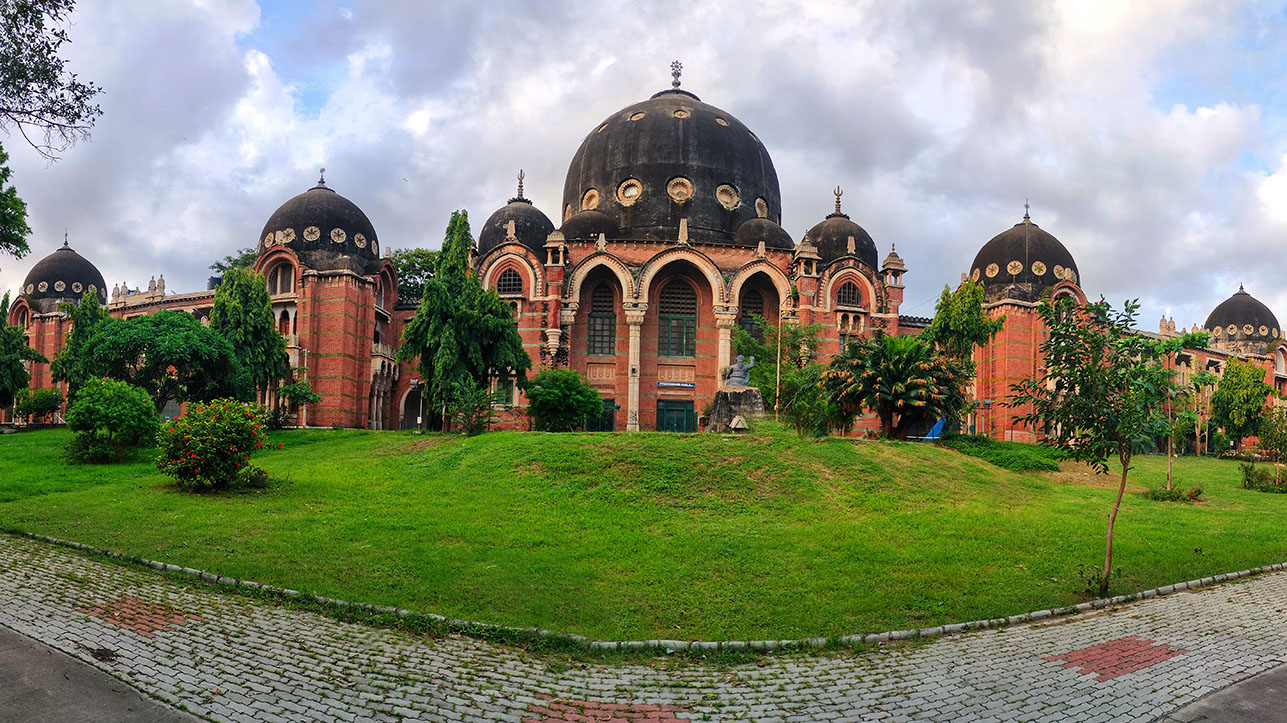
I got an opportunity to do my college internship in Vadodara way back in 1993. It was my first introduction to this city that has always held a special place in my heart. Vadodara is the perfect blend of nature and art, with a thriving cosmopolitan culture that adds a lot of diversity to the already vibrant art community. I have always enjoyed taking a stroll in the city, each time stumbling on new observations and fresh insights on familiar streets. Whether it is the stunning architecture of the Maharaja Sayajirao University, or the serene beauty of the Sayaji Baug, there is always something to admire in Vadodara. Especially, with so many heritage buildings scattered around the city, it is easy to find yourself immersed in the exclusive beauty of this unique place. I decided that the best way to absorb the essence of the city is to quietly stroll through the streets of Vadodara, taking in all that this wonderous city has to offer. Falling in love with it, yet again!
The moment my feet touched the soil of Vadodara, I felt compelled to first visit the Laxmi Vilas Palace. I think it was the best way to begin to explore the city after a gap of 20 years. I have narrated this experience in my previous travel story. It really set the tone and my intense curiosity led me to discover more new places that are fairly unknown to tourists at large. As I tried to gauge the vibe of the city, I took a kind of a slow travel as I sought out the hidden gems of Vadodara at my own pace.
Fortunately, Hotel Regenta Inn Vadodara where I was staying was located at the perfect spot in the city, it was the ideal base as it was central to all the important tourist spots. The hotel is located right next to the central bus depot and opposite to the railway station. You can easily get a shared Auto Rickshaw that costs Rs. 10 or 20 depending on the distance. There is a Jan Marg bus hub next block from where you can get public transport to almost all parts of Vadodara. The bus ticket costs anywhere between Rs. 4 to 15 one-way.
Sayaji Baug, also known as Kamati Baug, is a popular tourist place in Vadodara. The park's main entrance is located at Kalaghoda Circle, less than one kilometer from the railway station. From my hotel, I walked there in just 10 minutes. Sayaji Baug is a paradise for botanical lovers, a green Utopia that's home to 98 kinds of beautiful trees, lush plants, and vibrant flowers. Adding to this vibrant visual are the various kinds of water birds that adorn the large pond. It is that perfect spot for locals to go for a morning walk or to relax and imbibe the joys of nature.
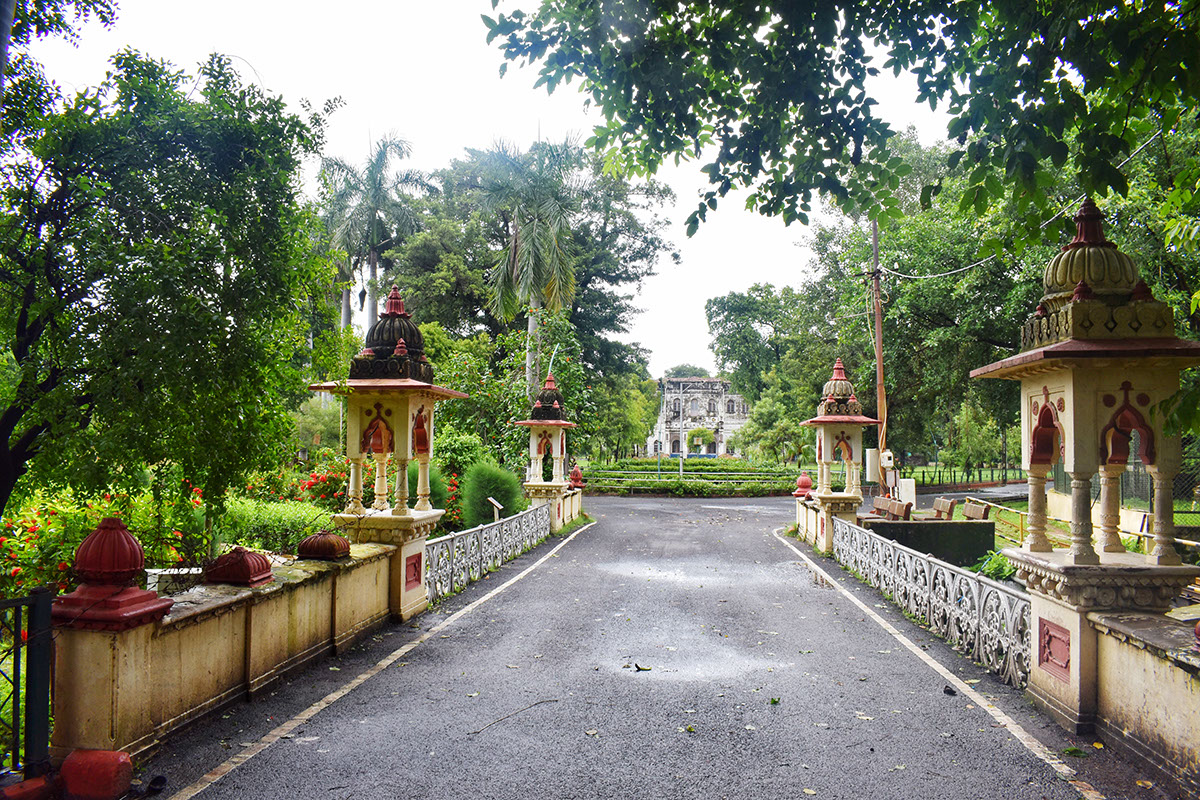
Kamati Baug's grand entrance gives a sense of the grandeur inside
Sayaji Baug is one of the largest public gardens in Western India. Built in 1879, it sprawls over 113 acres along the banks of the Vishwamitri River. It is open from 5 am to 9 pm. You do not have to pay an entry fee. There is no doubt that it is one of the best places to visit in Vadodara. The park is divided into two parts: the upper part has a number of colorful flower beds, playful fountains and intricate sculptures, while the lower part has a beautiful lake with boating facilities.
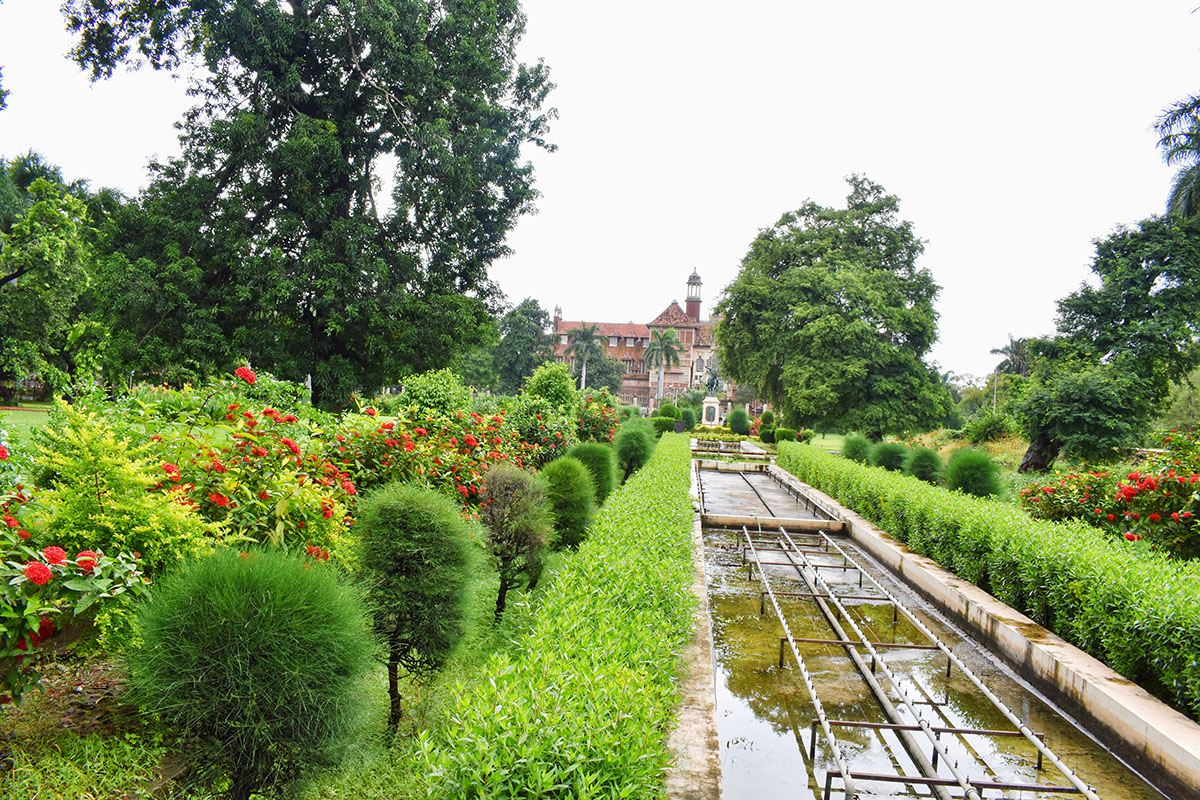
The fountains at Sayaji Baug garden are mesmerizing when it's flowing
Sayaji Baug in Vadodara is well known for its floral clock, which is a major attraction for visitors. The clock is one of only two of its kind in Gujarat, the machinery of the clock is concealed under the flowers and lawns. A 20-foot diameter dial is adorned with hour, minute, and seconds hands. The hands are driven by a weight-driven movement, and the clock is accurate to within one second per day. Unfortunately, compared to the pictures I had seen on the Internet, the clock did not appear to be in good condition during my visit.
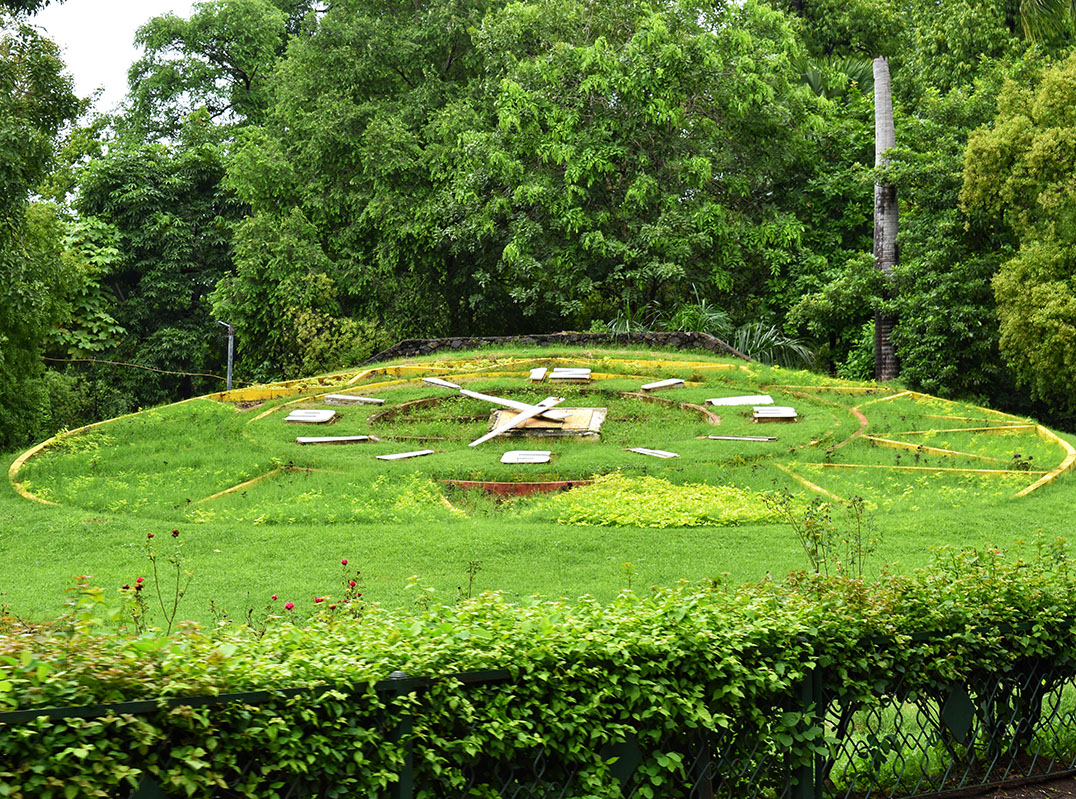
The evergreen floral clock
The Sayaji Baug Amphitheater is like the golden girl of Vadodara or the blue-eyed boy next door. Everyone loves the circular space which seems to welcome the city with open arms. It boasts a capacity of almost 500 people, so it's not surprising that all of the city's events take place here, making it the heart for cultural events like classical dance or vocal concerts. It's always filled with the sounds of music and surrounded by the buzz of humanity. It is the most mesmerizing sight during the monsoon, when it comes alive with the sound of rain.
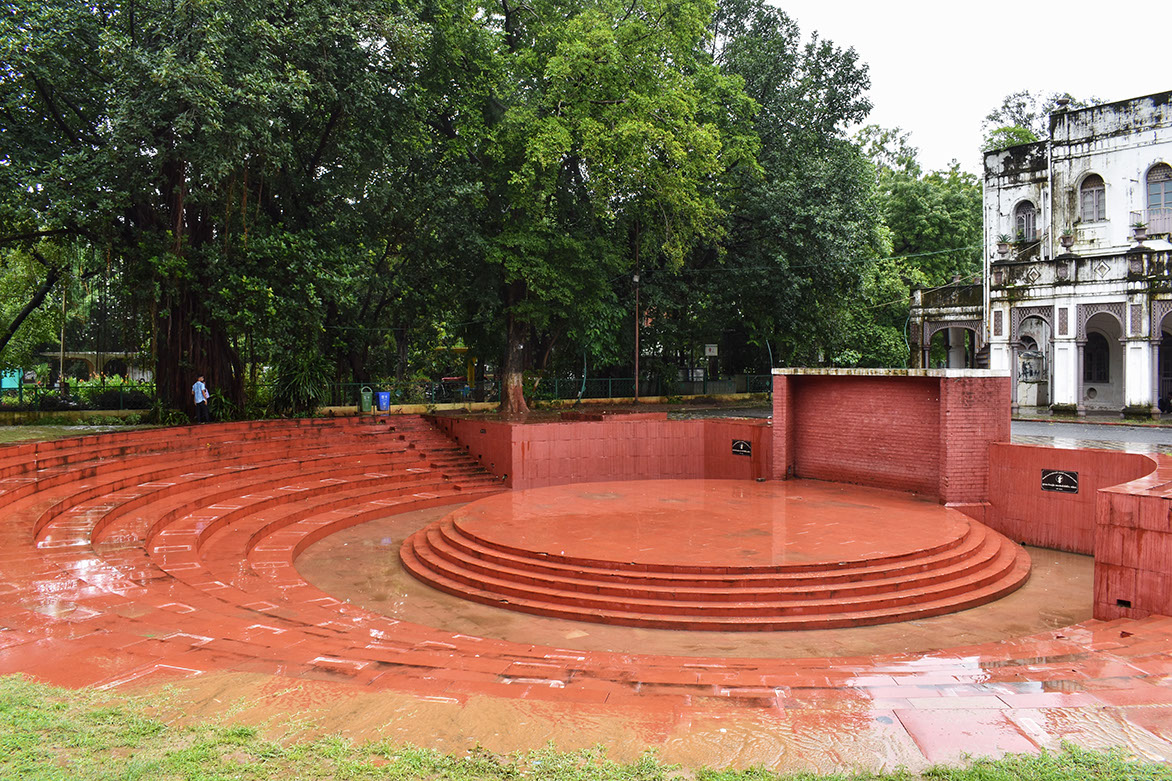
The heart of art & culture in Vadodara
The Joy Ride on Toy Train renders a classic feel to the tourist, offering a 360 degree view of the entire park during the ride of about 20 mins. It's one of the attractions that slows down a hurried tourist, enforcing a much needed breather. Its beautiful ride of about 3.5 km, along a 10-inch wide track, the pace of the ride cajoling one to sit back and relax.

It's also the perfect time to plan your day in the park, prioritizing the spots where you want to dwell on more. I, therefore, recommend taking the train ride at the beginning of your visit to the park. The engine is very old and was built by Severn Lamb Company, UK. It costs Rs. 50 per passenger to ride on the train.
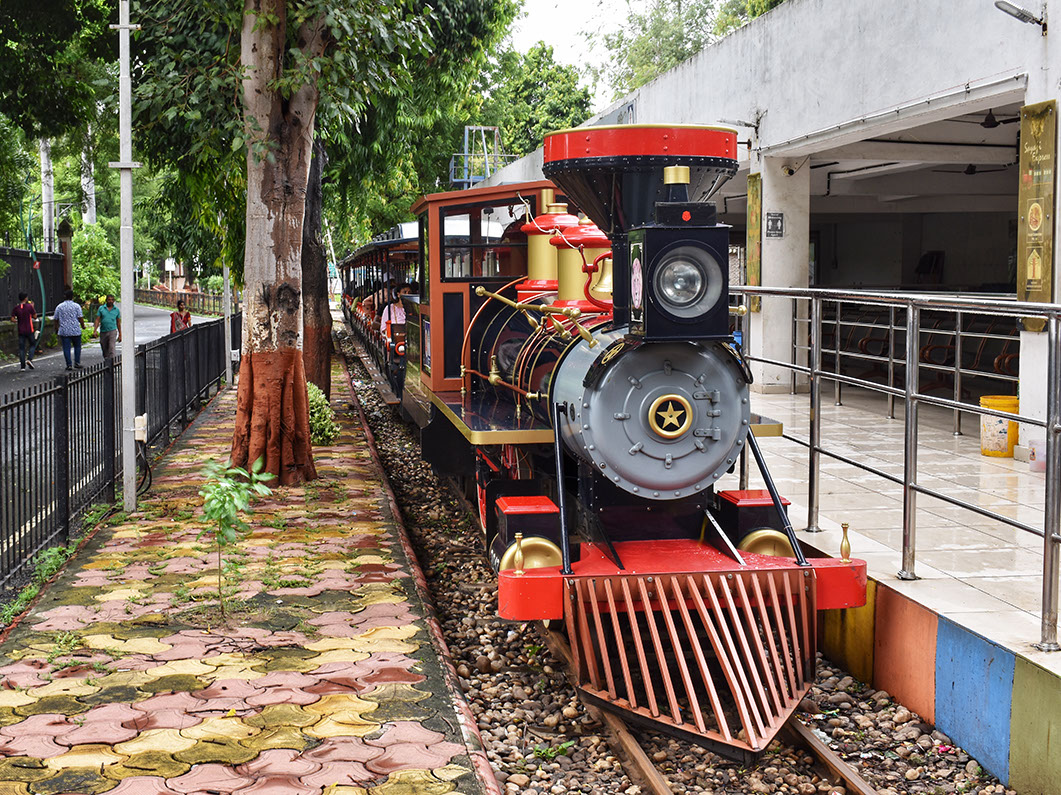
The joyous ride on a vintage train
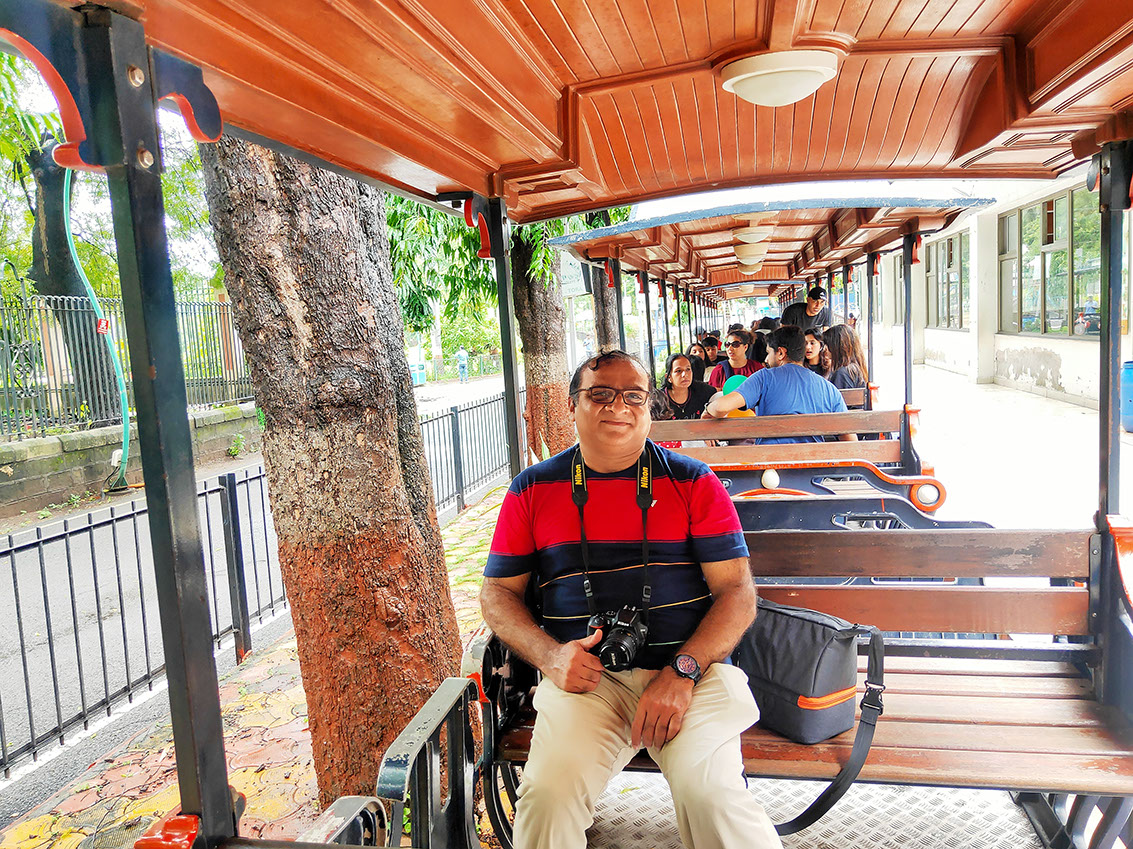
Slowing down for a bit was more fun than I thought
The park also boasts of the imposing Baroda Museum and Picture Gallery, which displays art, sculpture, ethnography, and ethnology. An alluring structure that now works as a museum was a heritage building. The spectacular and striking sculptures of Lions adorning the steps on the rear side is a show-stopper. There is an entrance fee of Rs. 150 and photography is not allowed inside the museum.
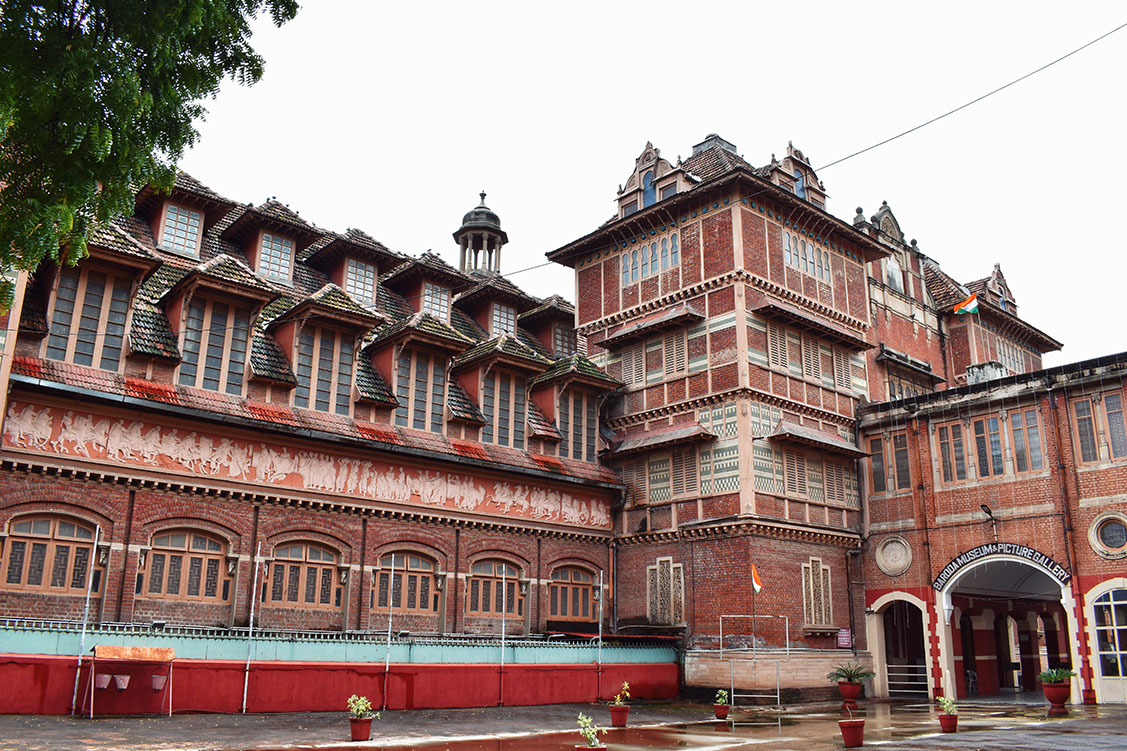
Baroda museum and picture gallery is spectacular and a definite show-stopper
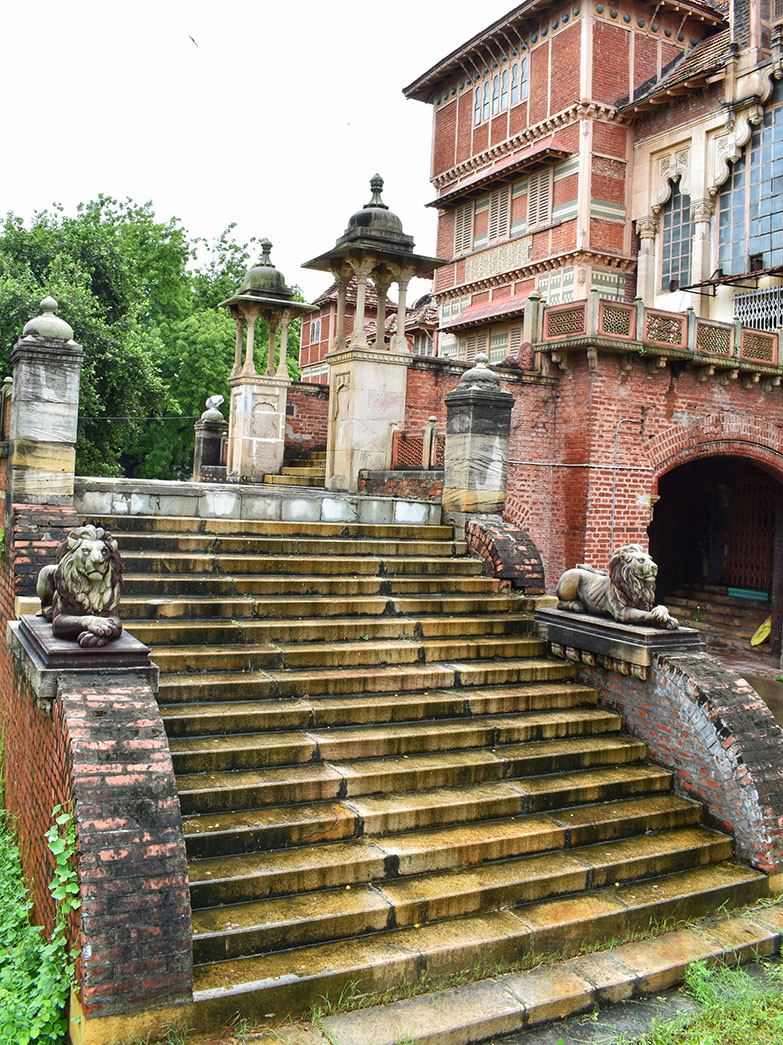
Striking and superimposing, the museum entrance are the historical sculptures of two lions
It's rather unfortunate that the park's zoo isn't well maintained but if you still want to take a peek, there is a separate entry fee for that. There is also a museum dedicated to health and hygiene, but it is currently closed and in dilapidated condition. In addition to these attractions, the Sardar Patel Planetarium is also worth mentioning. It displays a rather interesting exhibit! It also hosts an audio-visual show daily at 4 PM (Gujarati), 5 PM (English), and 6 PM (Hindi) for Rs. 10.
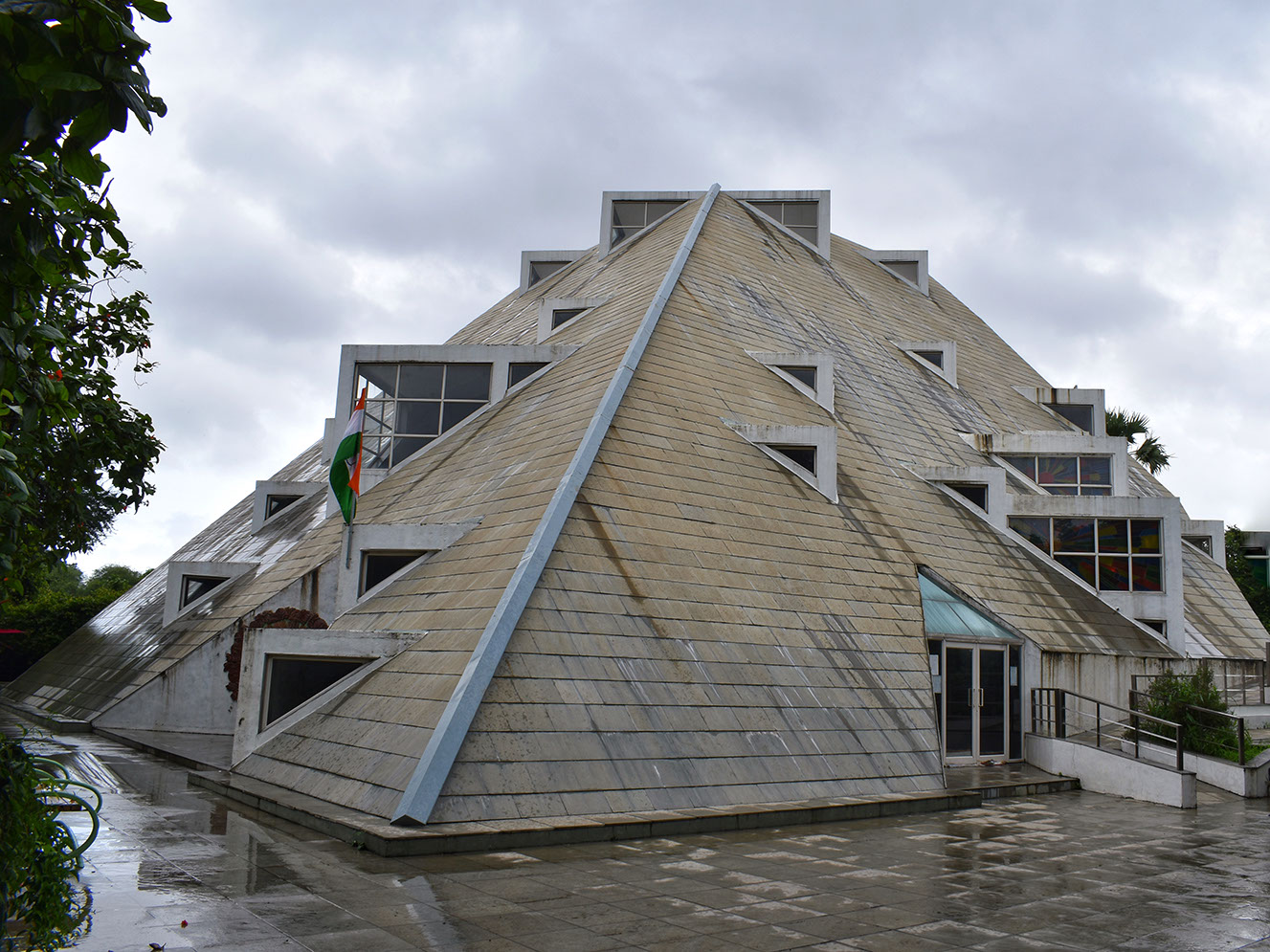
The Sardar Patel Planetarium for the star gazers
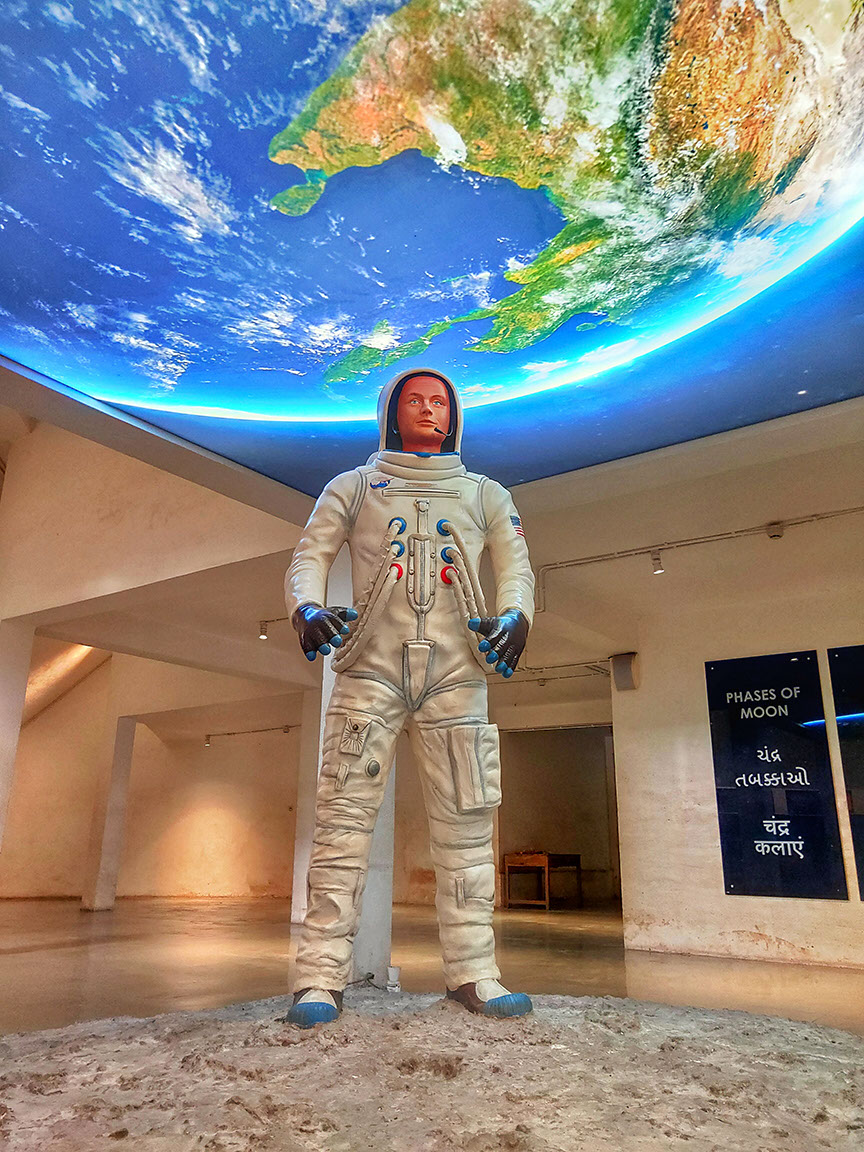
The Show-stopper
Across the bridge on the Vishwamitra River, a few blocks down Sayaji Baug, is Kirti Mandir, a quintessential Shiva temple dedicated to the ancestors of the Gaekwad family. I love the archetypal structure that speaks of a bygone era, the color of its historical walls and gray-haired vibe subtly hint at its legacy. The edifice is dedicated to Lord Mahadev and was built in 1936 to celebrate the Diamond Jubilee of Maharaja Sayajirao Gaekwad III. The main hall of the temple has intricately designed pillars and ceilings painted with scenes from Lord Shiva's life. This visual stopped me in my tracks as I tried to imagine a life that was beyond my grasp and understanding. It is no wonder that the Kirti Mandir attracts thousands of devotees every year during Maha Shivratri. Vadodara's rich cultural heritage is reflected in its beautiful architecture, its stories calling out to people to come and bask in its charming legacy.
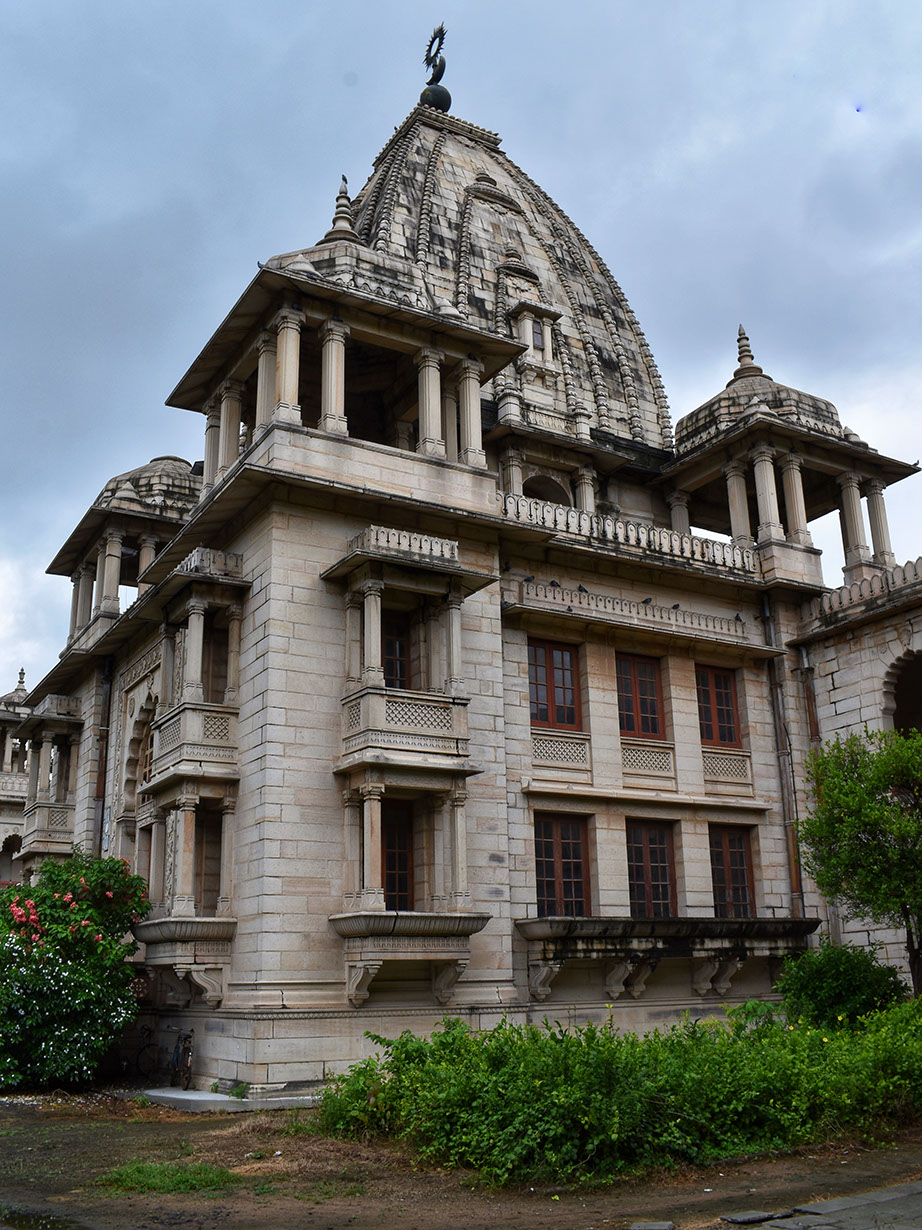
Kirti Mandir's gray-haired, historical walls speak of its legacy
In collaboration with the state architect V R Talwarkar, Sir Edward Lutyens designed the building. The stone building resembles the letter E and includes terraces, balconies, and domes. Marble adorns the interior of the central shikhara, which stands 35 meters tall. The murals in the central hall were painted by renowned Bengali artist Nandalal Bose. Their depictions of Indian mythology and the Mahabharata battle are truly breathtaking.
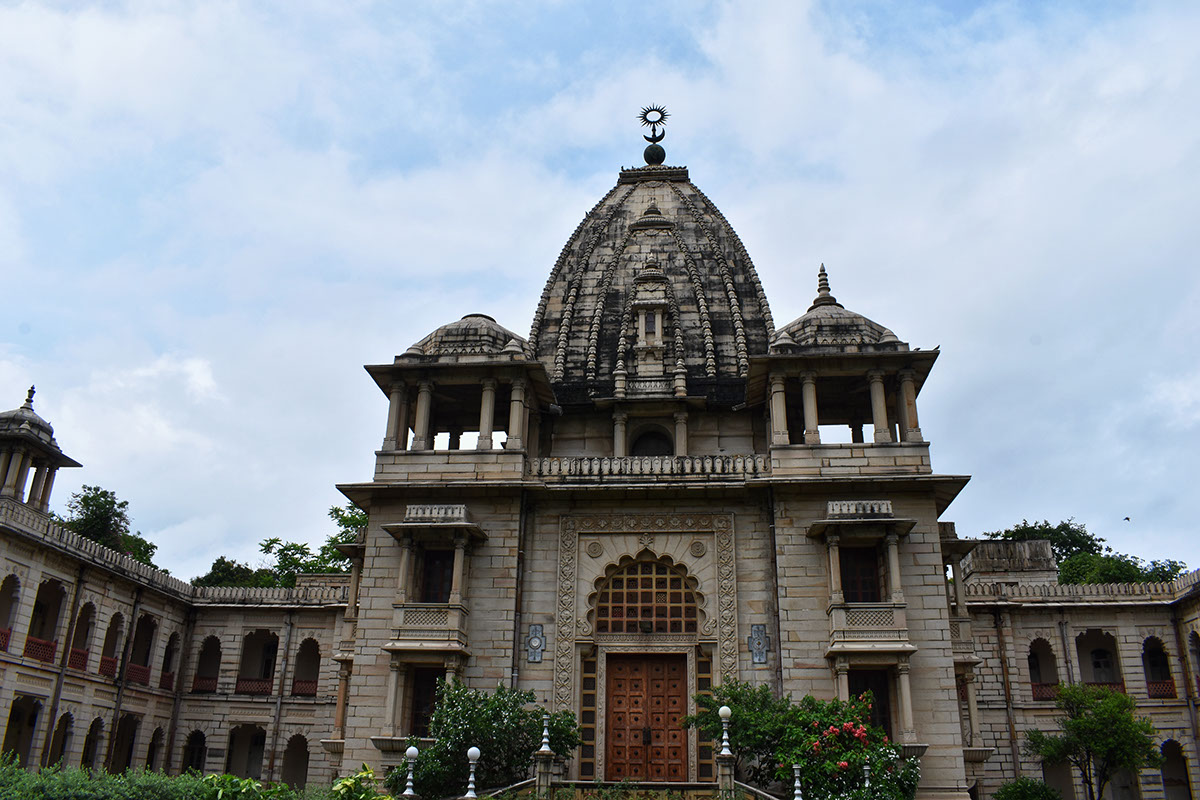
The immortality of a bygone era
It is quite unimaginable in these times to believe that such a spectacular three-storey temple was built for Rs. 50,000. The first floor has amazing statues of other members of the Gaekwad family. The second floor has a gallery with beautiful photographs of all the members of the royal family. Shikharas (spires) atop the temple depict the sun, the moon, and the earth in bronze, with relief images of the undivided map of India.
Wada (also called wado in Marathi) was the name of an imperial residence built during the rule of the Peshwas. It is an amalgamation of Rajasthani, Mughal and Gujarati architecture. The large and spacious Wadas were usually built by wealthy people who held significant positions within the monarchy. The building is rectangular and located right near the main street in typical style of that era. It is common for such streets to be narrow in order to accommodate future growth. They never had a garden or a vista. Several rooms and balconies were placed around an open courtyard in these 2-3 storeyed buildings, with a steep staircase leading to the upper floors.
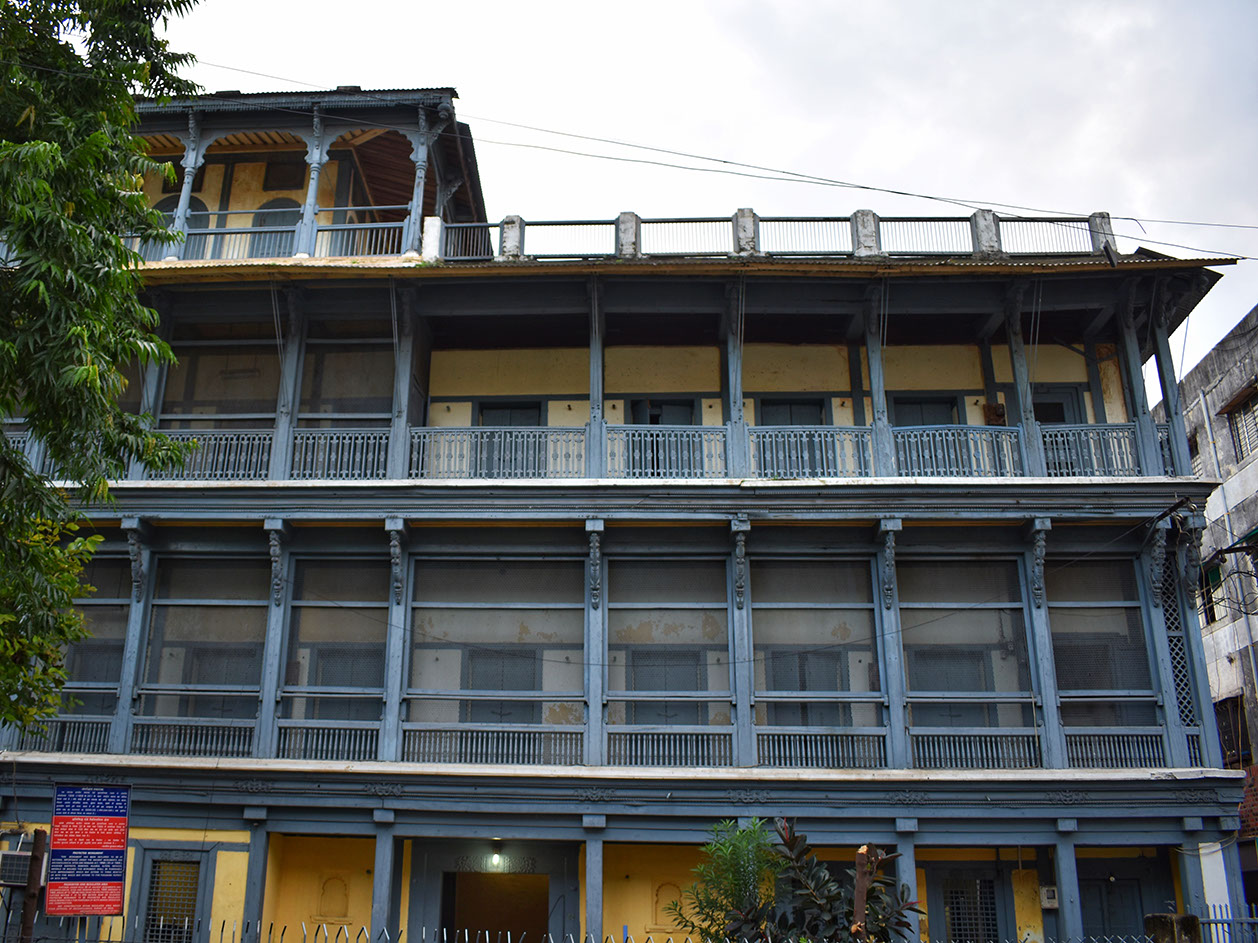
The unassuming Tambekar Wada which holds a treasure of art, an unexpected tourist delight
The Tambekar Wada is an unassuming 170-year-old maratha mansion in Raopura at Tambekar no Khancho in Vadodara's old city. Vithalrao Khanderao Tambekar, also known as Bhau Tambekar, built the house as a private residence. Tambekars originated from Tambwe village in Satara, Maharashtra. They were "Sahukars" (wealthy) who raised money for the Maratha armies and were therefore rewarded with prominent positions. Between 1849 and 1854, Bhau served as the Deewan (Finance Minister) for Ganpatrao Gaekwad (the ninth Maharaja of Vadodara). In spite of its simple appearance, this three-story wooden mansion hides a wealth of art and culture. Its walls are vibrant with impactful visuals that tell mesmerizing stories, enough to keep a visitor glued to these walls for days.
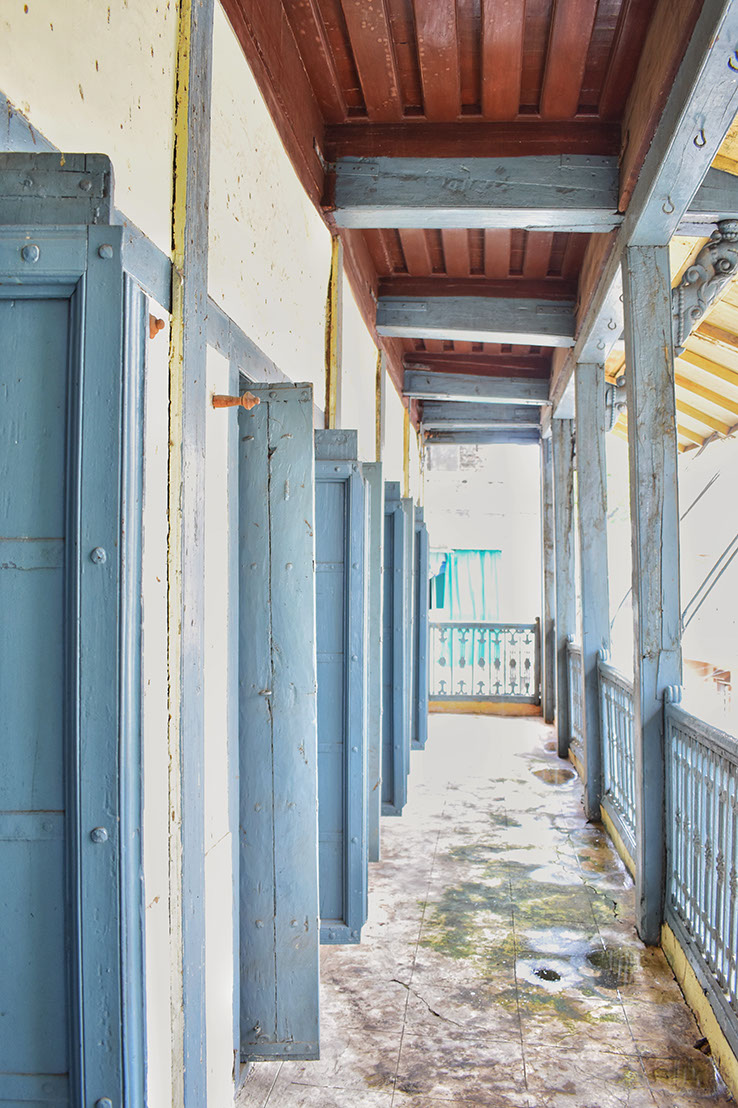
Second floor balcony corridor of Tambekar Wada
The only surviving relic of maratha heritage in the city boasts of exquisite murals and artwork inside. I was truly spellbound once I entered the building's first floor. Invaluable pieces of artwork have been immortalized on these decrepit walls. My pictures were unable to capture the unseen glory of yesteryears hidden in the archives of history. Time has not been kind to these beautiful treasures and due to negligence, some of the murals have faded. Nevertheless, the Archeological Survey of India (ASI) has taken over the responsibility and declared Tambekar Wada a heritage building. Ajay, one of the officers of ASI, escorted me up the narrow and steep staircase through the courtyard to the upper floors.
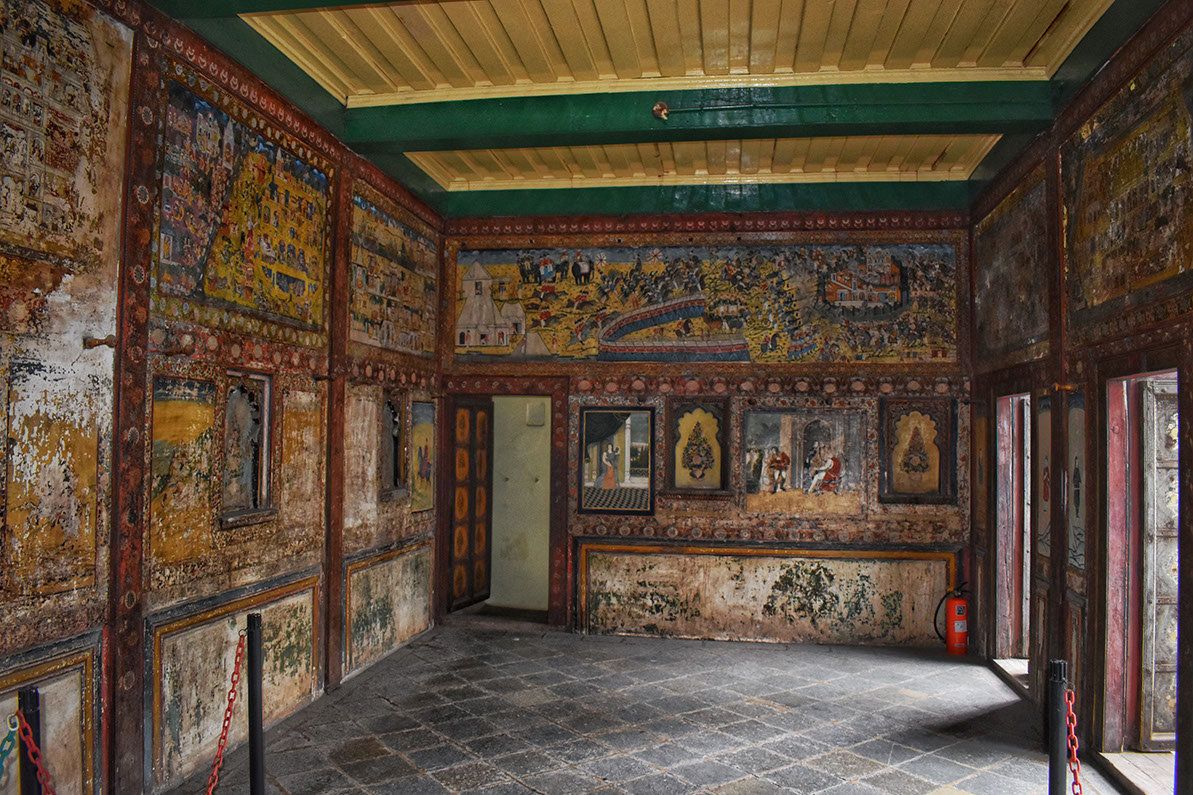
Paintings from different schools of art decorate the first floor hall
The Tambekar Wada is divided into two sections, the front and the residence. Front section is accessible from outside and has a guardhouse on ground level. ASI has set up their office here. The first floor was reserved for guests who were escorted directly from the courtyard. I was flabbergasted as soon as Ajay opened the first floor door. It felt like I had been thrown into a riot of colors. A wide variety of paintings are displayed throughout the hall, displaying different schools of art. Among the exhibits are murals from the 17th and 18th centuries, as well as some from the 19th century showcasing the daily life of Marathwada people. Lord Krishna is depicted in many paintings, starting from his birth to his childhood days of breaking butter pots and performing Ras Garba (traditional dance ceremony) with Gopis. It was a journey back in time and I was a willing traveler.
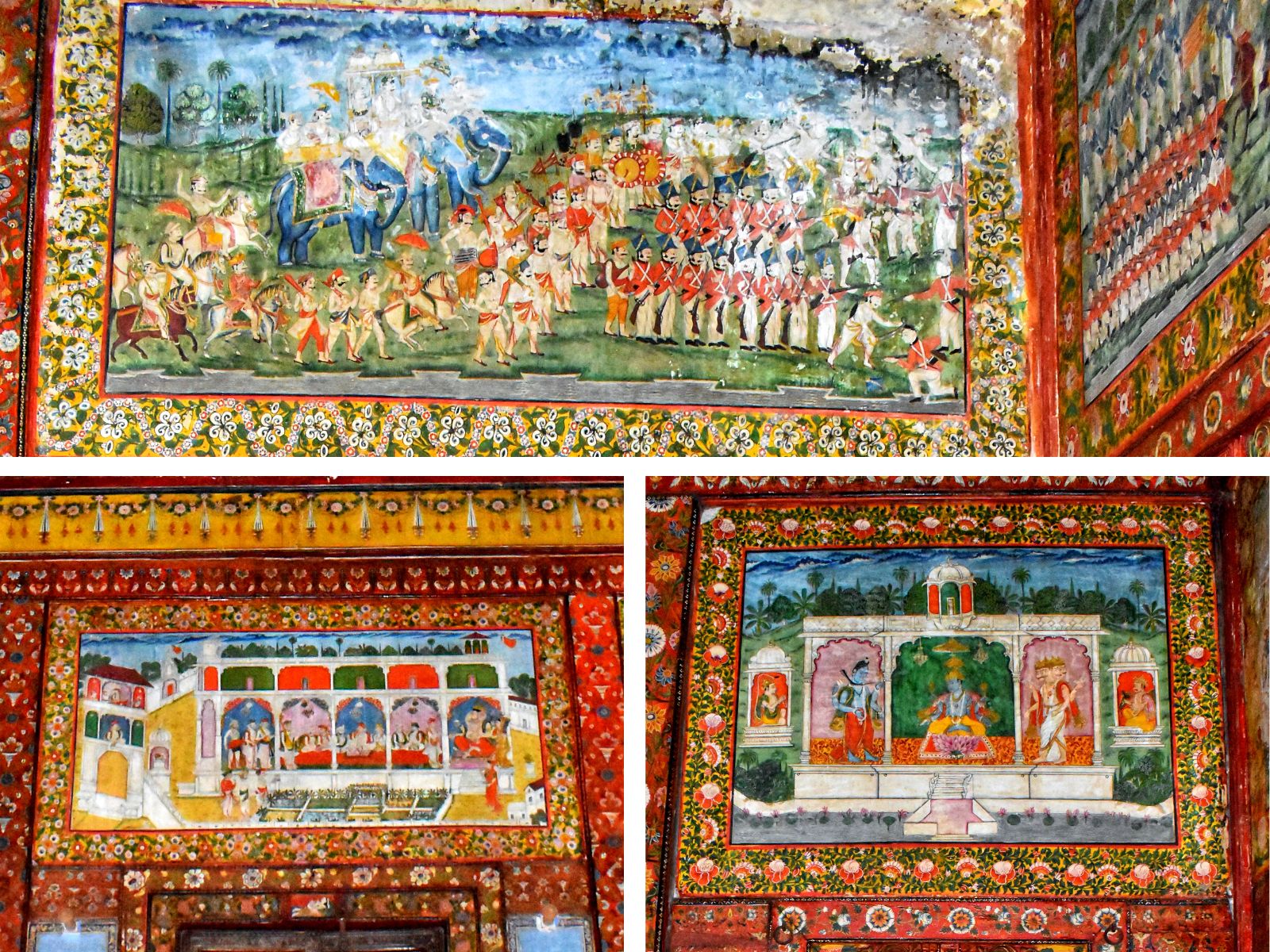
Mural depictions of Maratha war (top), Ganesh Chaturthi celebrations (bottom-left) and various Hindu deities (bottom-right)
These murals were painted with Tempera painting, a method that uses an albuminous medium like egg yolks or egg whites diluted in water to bind pigments. The word Tempera is derived from the verb temper, which means "to bring to a desired consistency". Murals on wooden surfaces have used a different technique where opaque water-based pigments are varnished with lacquer. This is an amazing technique that is commonly seen in Rajasthani Qalam.
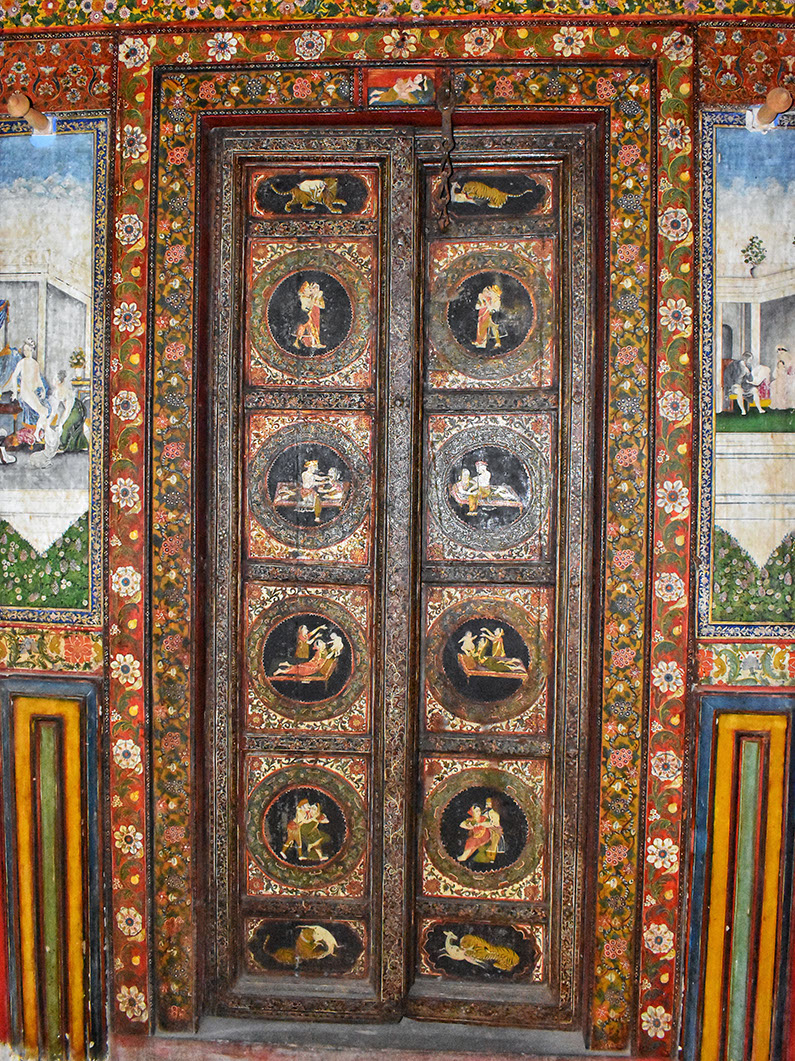
One of the doors leading to the residence section is decorated with erotic paintings
On the first floor, the hall is divided by a beautifully carved wooden screen. The depiction on the door is vivid and resonant of the times, giving insight to life of those times. There is a belief that this portion was reserved for women who followed the "purdah" (curtain) system. Various painted wooden doors are fitted within the mural painted wall on the right side of the hall, providing separate access to both portions of the hall from the residence section. Hosts enter through these doors to welcome guests. There are a few doors that open to the balcony on the opposite side of the wall (on the left).
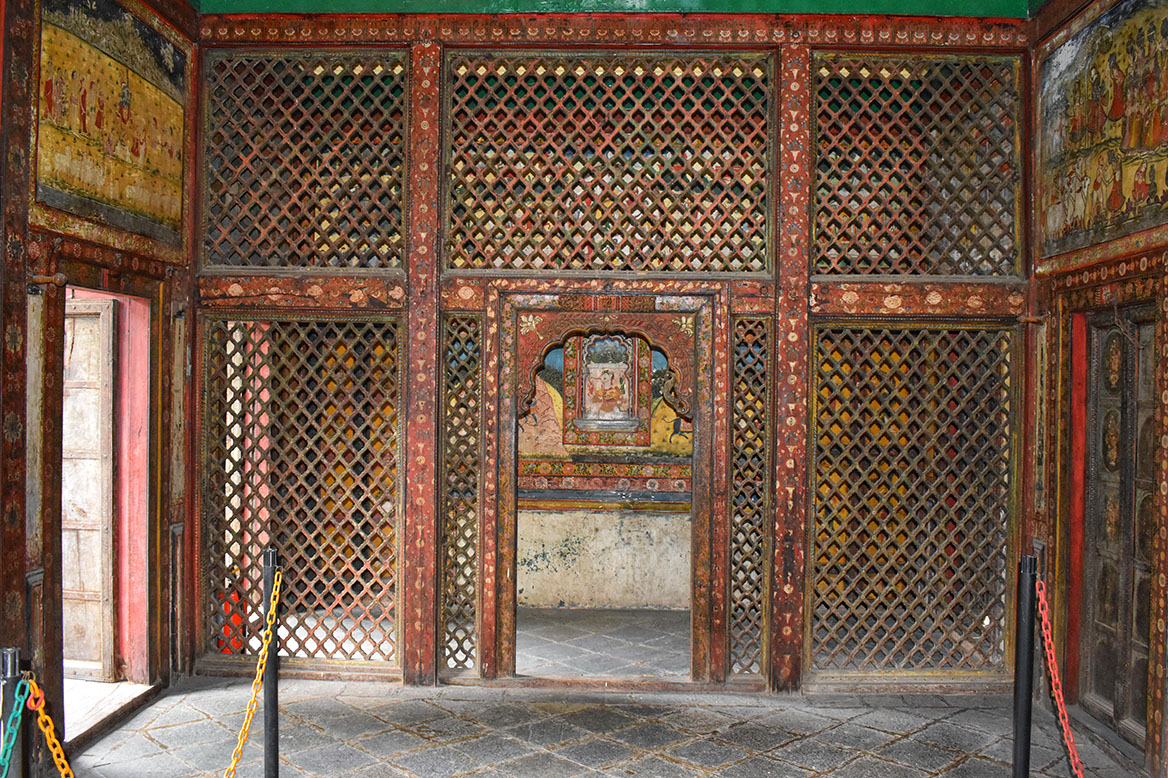
A portion of the first floor reserved for women who follow "purdah"
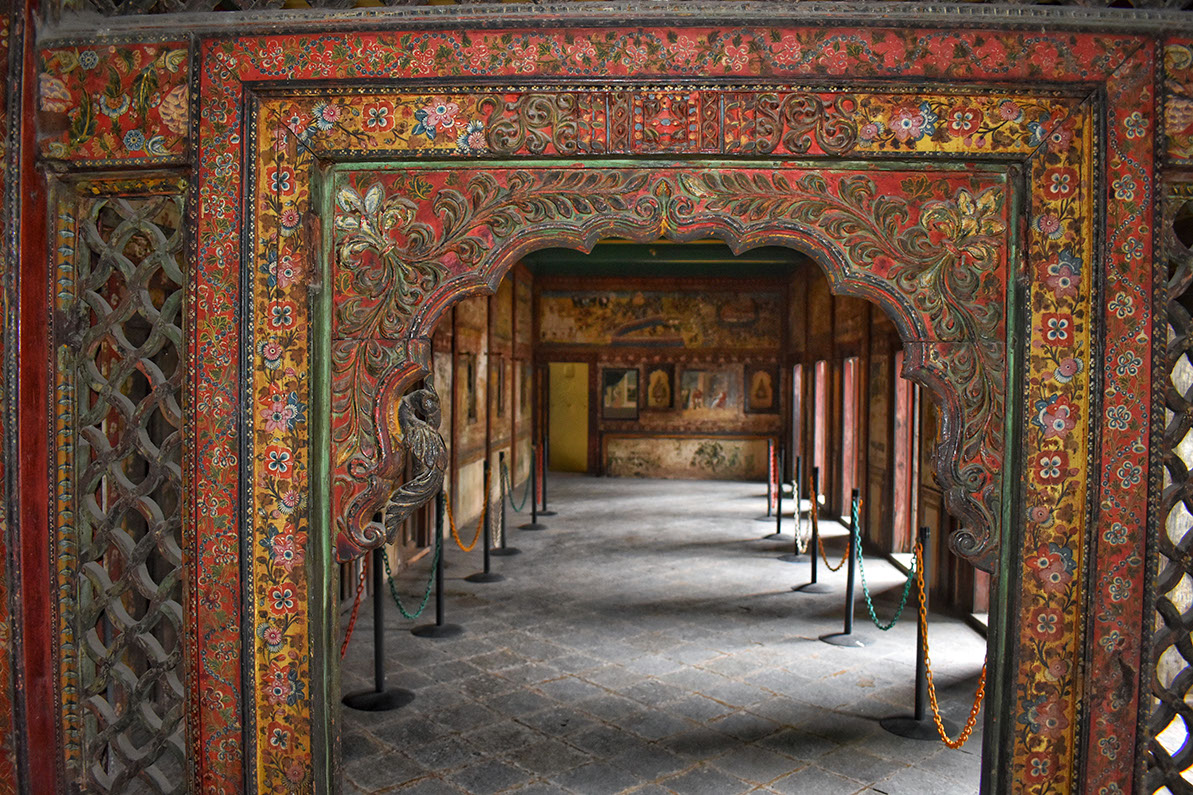
A carved wooden screen on the first floor with beautiful floral paintings
The amount of details I captured with my camera intrigued Ajay. When I thought I was done with my visit, he told me the second floor had even more intriguing murals and asked me to follow him up one more flight of stairs. As soon as the door was opened, I could sense something amazing was beyond the darkness. As Ajay was about to open the balcony's doors, I stopped him from doing so. I wanted to click a picture with the flash on and was completely astounded by the treasure that greeted me. I was in historical heaven. Everything in that place screamed volumes, every drop of color, every hued story seemed like manna from generous skies.
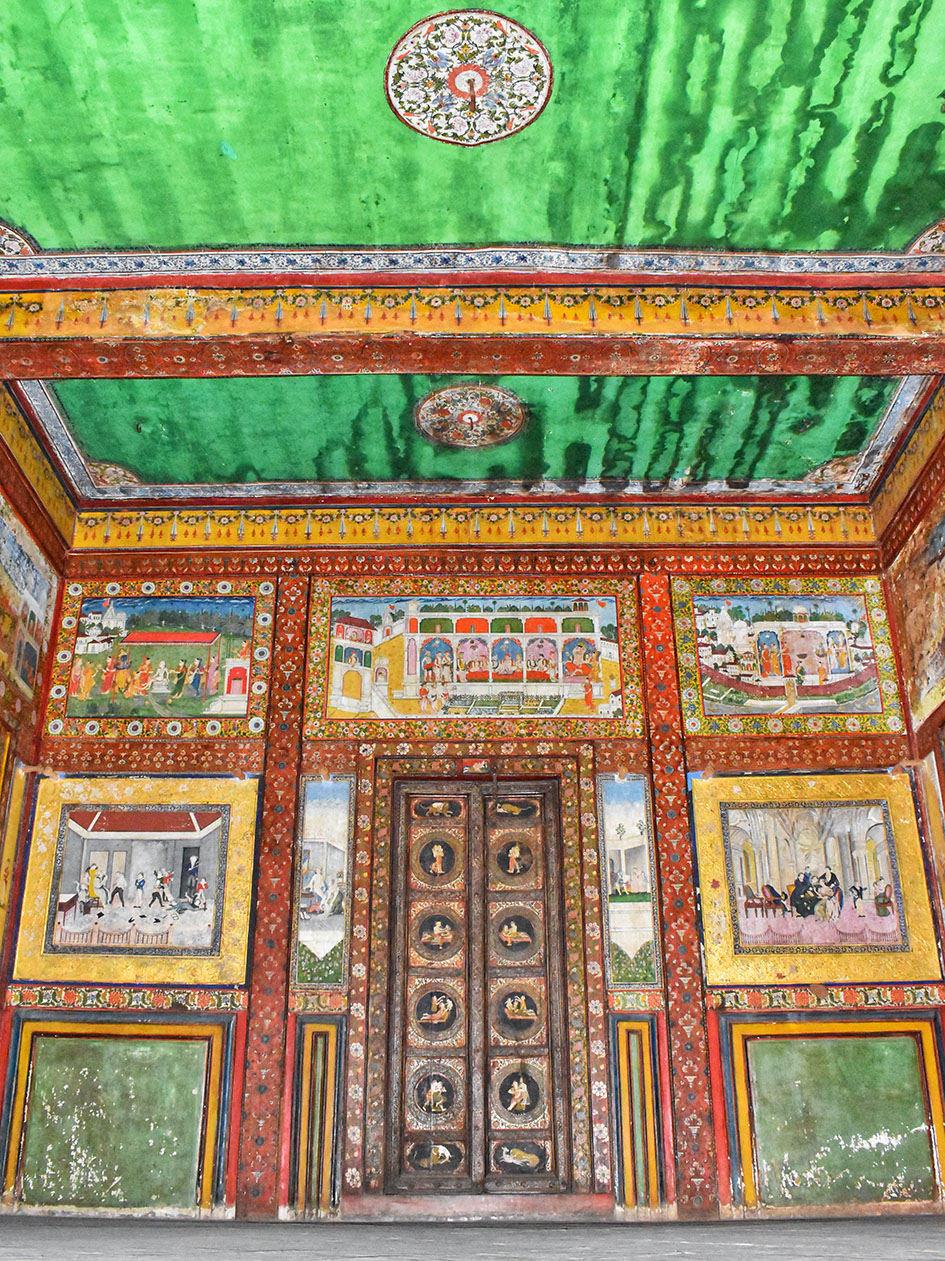
A beautifully painted second floor with brightly colored flower depictions on the ceilings
I was pleasantly surprised and it took me a few seconds to gauge the intensity of art and its vibrant versatility. I felt blessed to be surrounded by this reality. I shared my captures with Ajay, he was equally mesmerized as if he was seeing it for the first time. "Wow, great shot, he exclaimed!" On this floor, every inch of the walls and roof was used as a canvas, including the door and window panels. If the first floor was a riot of colors then this room was chaotic and calm, presenting a vibrant visual, more beautiful than one can ever imagine. There were scenes from the Mahabharata, the Anglo-Maratha wars, contemporary art, as well as some intimate portraits. It was a fusion of creativity that told stories on small screens. I was exhilarated at this find, my lens drawn to every inch, wanting to take in everything at the same time, afraid of missing out some important details. My heart was pounding with excitement as I struggled to focus.
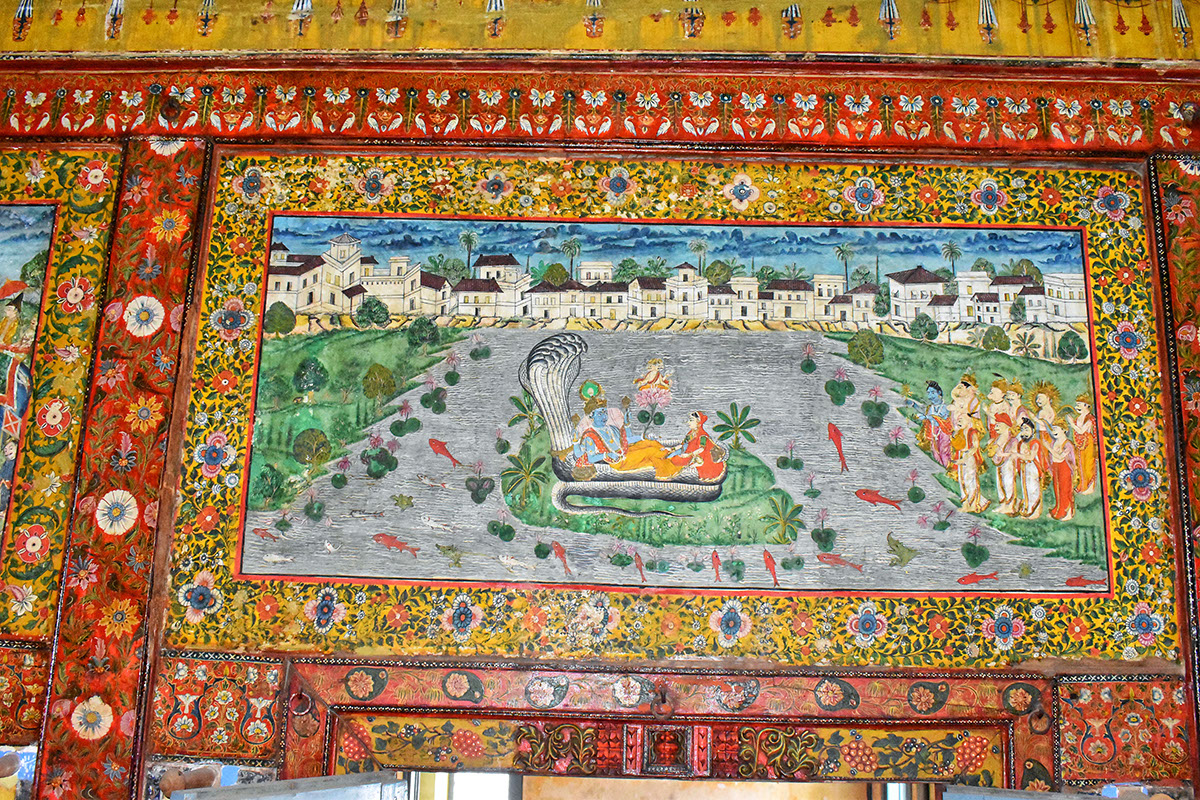
A depiction showing Lord Vishnu, Goddess Laxmi, and Lord Brahma listening to a plea from other gods
After Tambekars left, the Wada was turned into a school and a few paintings were destroyed by curious children. ASI has put a lot of effort into restoring these paintings. There are ruins left in the residence section of the building. The dilapidated section, however, does not belong to ASI, but to Vadodara Municipal Corporation.
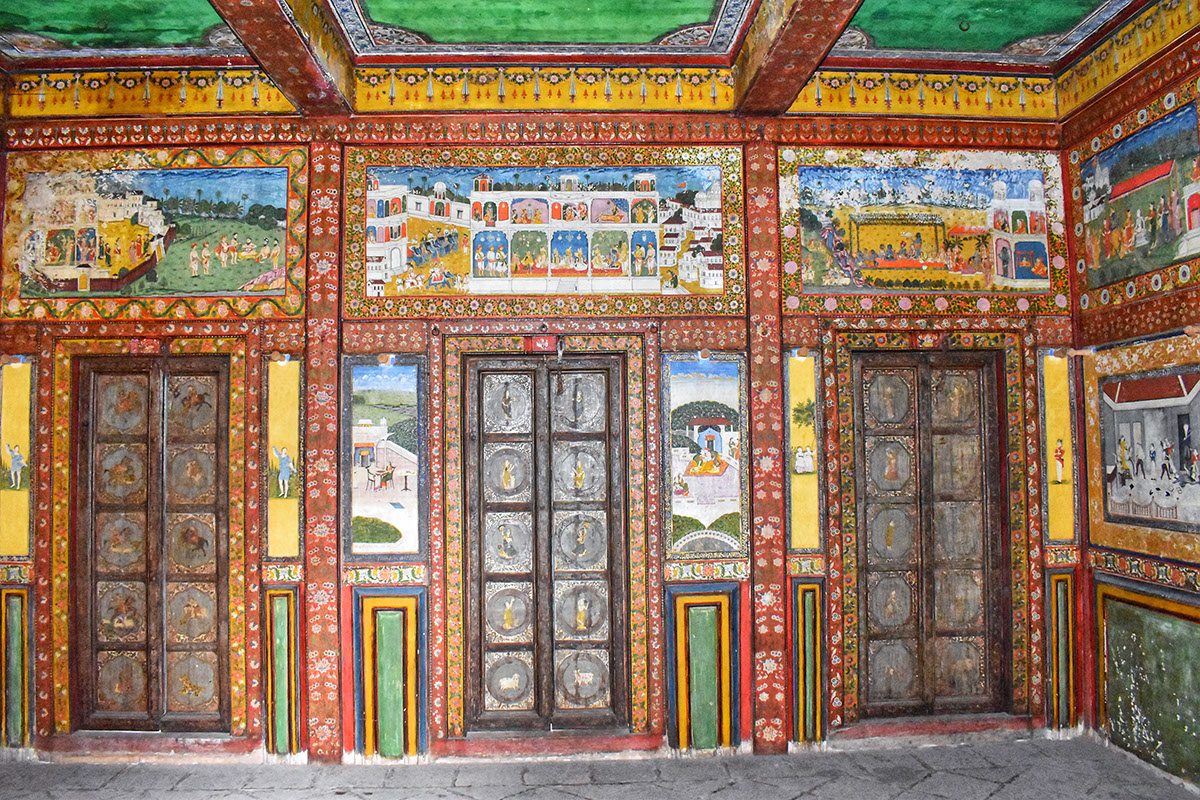
Murals portraying stories from Hindu mythology, life of people, and European-style paintings
Sometimes I like to be a Flaneur and do things on the fly. This historical city of Gujarat has something to offer everyone. It doesn't matter if you are a history buff, art lover, or foodie - everyone can enjoy a visit to Vadodara. After navigating those narrow lanes, a kilometer further on brought me to Khanderao Market, an iconic heritage building. It was a crowded Vadodara Municipal Corporation office. What got my wavering attention was a beautiful towering gate adorned with a big clock in the center and flanked by "jharokhas". I ran into a gentleman who was managing the parking lot of the building. His curiosity was piqued when he saw me with my camera, scouting for the perfect angle for a picture of the towers because he himself was once a professional photographer.
In addition to giving me tips on taking pictures, he also provided me with some vital information about this heritage building. Moreover, he informed me that there are guided tours for exploring the heritage sites in Vadodara.
The story goes that Maharaja Sayajirao Gaekwad III presented this sprawling market to the municipality in 1907 in celebration of the silver jubilee of his reign. It was named after the previous ruler and his late adoptive father Maharaja Khanderao Gaekwad II.
Main entrance resembles the gate at Dabhoi Fort. The stone parapets have been modeled after Agra Screens (Jalis) found in the Taj Mahal. Those towers look exactly like Kirti Mandir. Robert Chisholm, who was responsible for the construction of Laxmi Vilas Palace, completed this building as his last project. An imposing gateway with two "shikhars" (towers) and an adjoining facade displays the Gaekwads royal symbol. The facade is embellished with "chattris" (umbrella-style dome) and "torans" (an arch supporting the balcony). The building is not in a dilapidated state, but is not adequately maintained. Stones have blackened and trees have grown in some areas of the structure. A buzzing vegetable, fruit, and flower market greets you once you enter the gate.
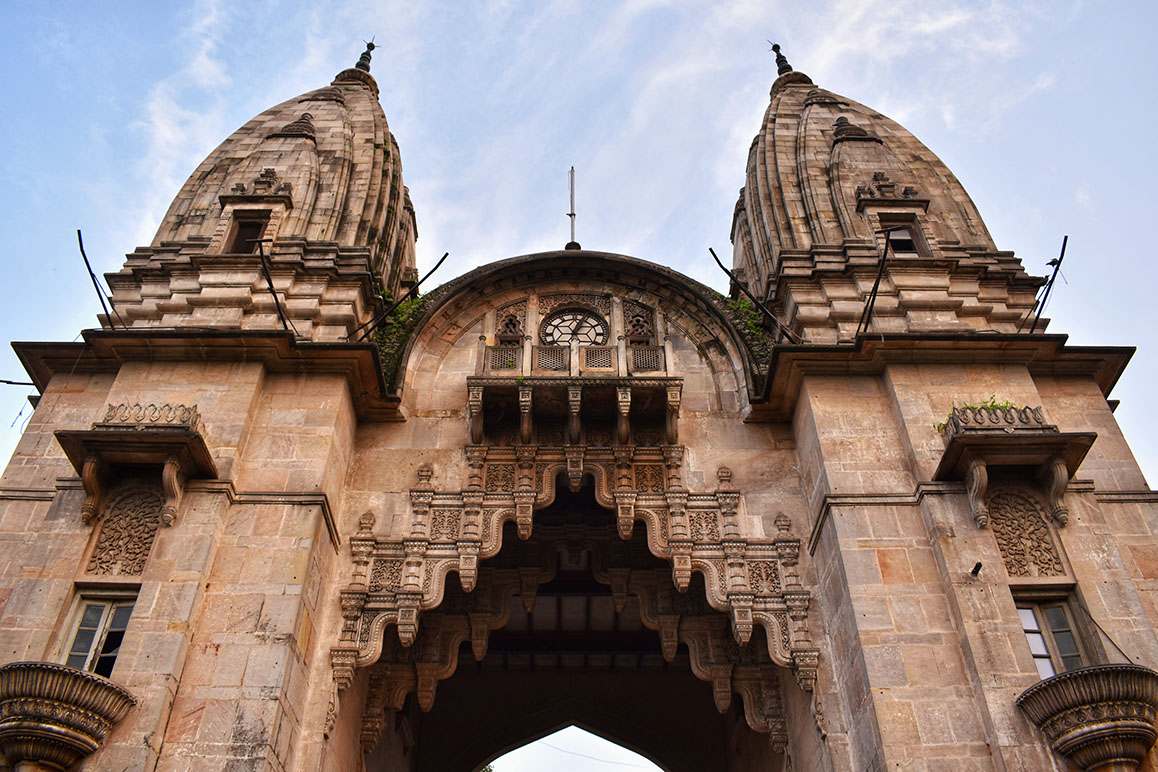
The entrance to the buzzing Khanderao market
A trip to Vadodara would not be complete without sampling its famous street food. It's a paradise for egg lovers, like me. Every nook and cranny of the city is full of street vendors preparing mouth-watering egg dishes, some of which you may not have tried before. Please give it a try, you won't be disappointed. There is also the option of taking a guided food tasting tour in Vadodara.
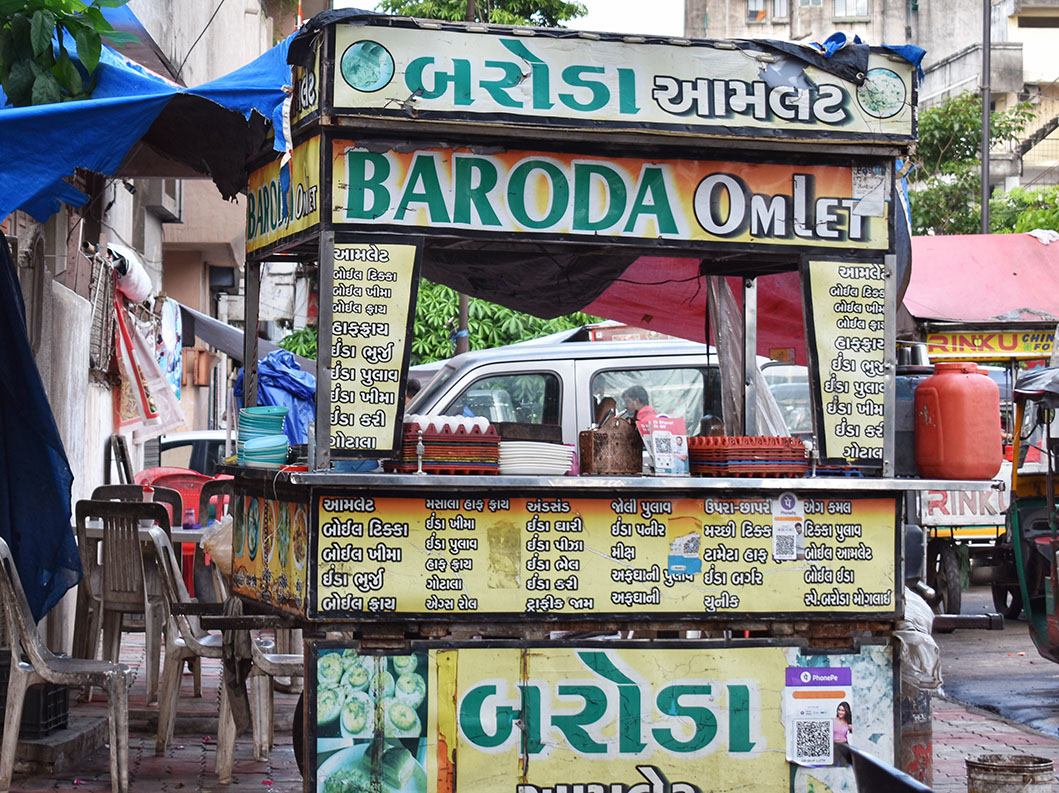
A street outlet's menu is too tempting not to try at least one item
Away from the bustle of the city and in a secluded location lies the mausoleum of Qutb-Ud-Din Muhammad Khan, a reminder of pre-Gaekwad era. "Hajiro," as it is known among locals contains the graves of Qutb-Ud-Din and his family. His tenure as governor of Gujarat was delegated by Akbar the great and ended with his death in 1583 at the hands of Muzaffar III, Gujarat's last Sultan.
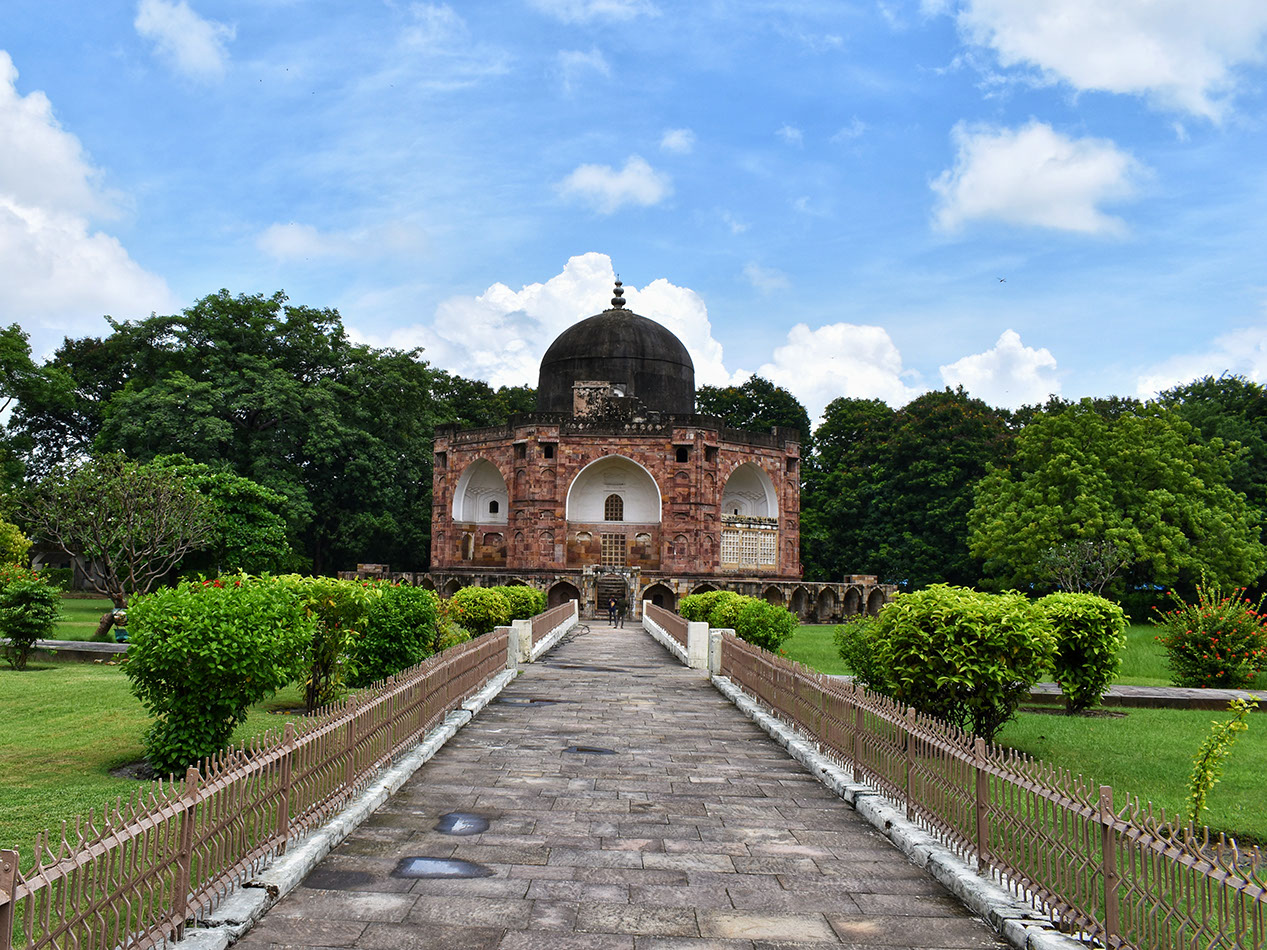
The mausoleum of Qutb-Ud-Din Muhammad Khan
A monumental structure constructed using sand stones on a high octagonal platform is situated within the Persian-style garden known as "Chahar Baug". The garden is believed to have been supplied with water by a small step well located across the road. The square platform on which the mausoleum stands has five arched niches at its base facing the four cardinal directions. You can enter the maqbara from the upper level of the central niche. Each side of the octagonal structure is built with a formidable "ogee" (islamic arch). Arched openings of smaller sizes are adorned with a group of square screens (jalis), each with a different geometric pattern. It certainly has a lot of details and much to be admired. I loved the minute attention to all the little things that together made it a beautiful sight. Heritage lovers should not miss this place.
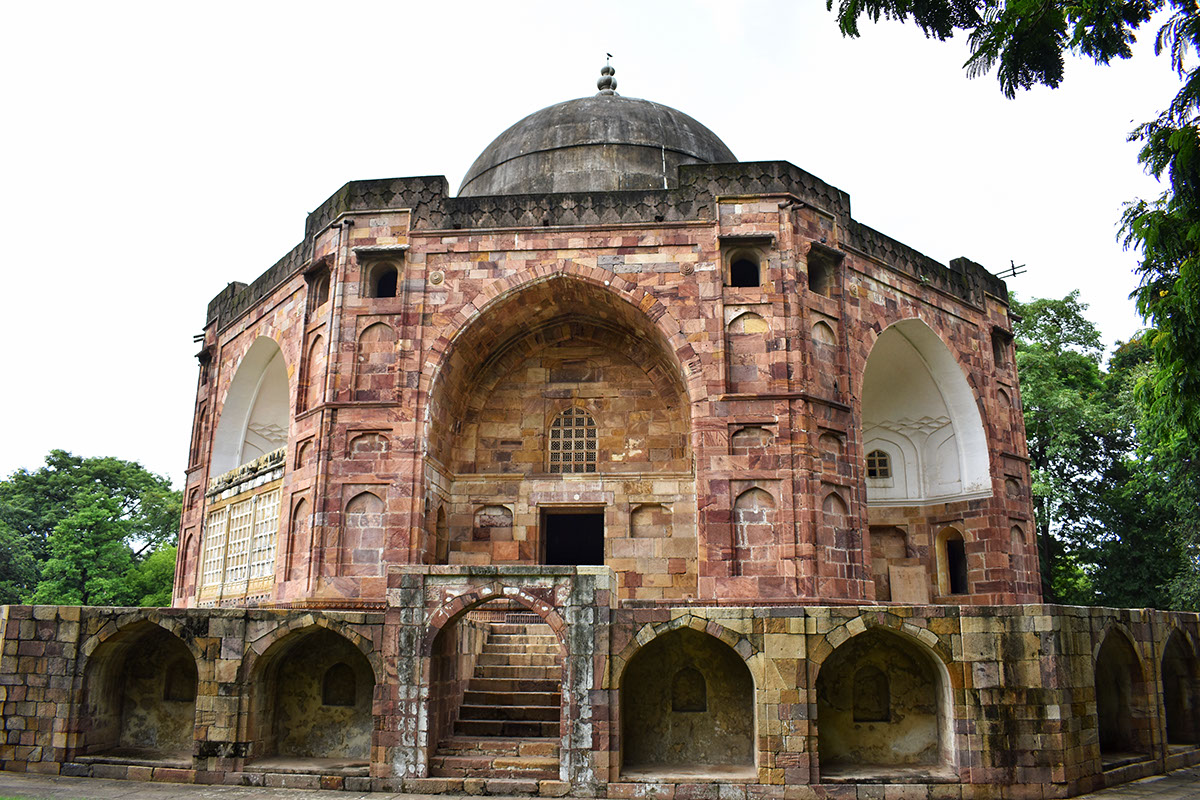
Five arches encircle the maqbara platform at its base
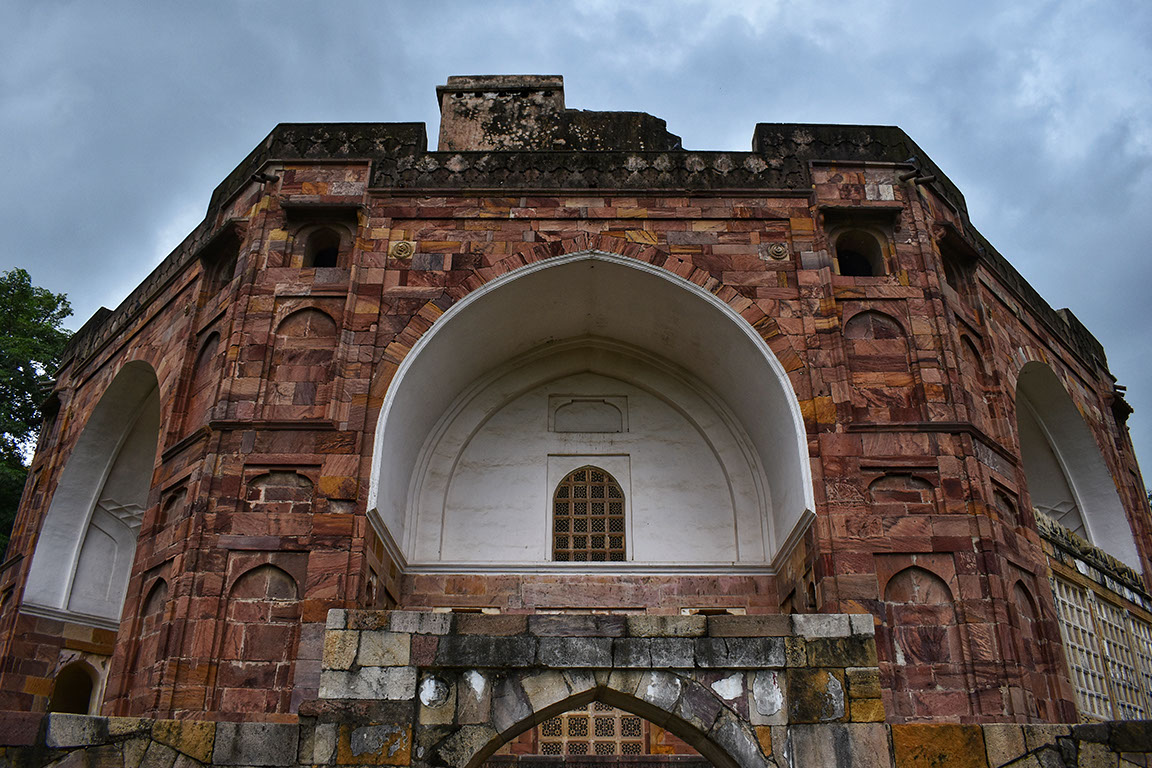
An Islamic arch with different geometric shapes on the window
In 1586, the Mausoleum was built with a double dome Mughal architecture similar to Humayun's Tomb in Delhi. The parapet of the dome is adorned with a "Merlon" motif. A cenotaph (a false grave) marks the burial site in the tomb chamber, whereas the original grave is in the underground chamber. The eastern side of the chamber has Quranic verses engraved inside the "jalis."
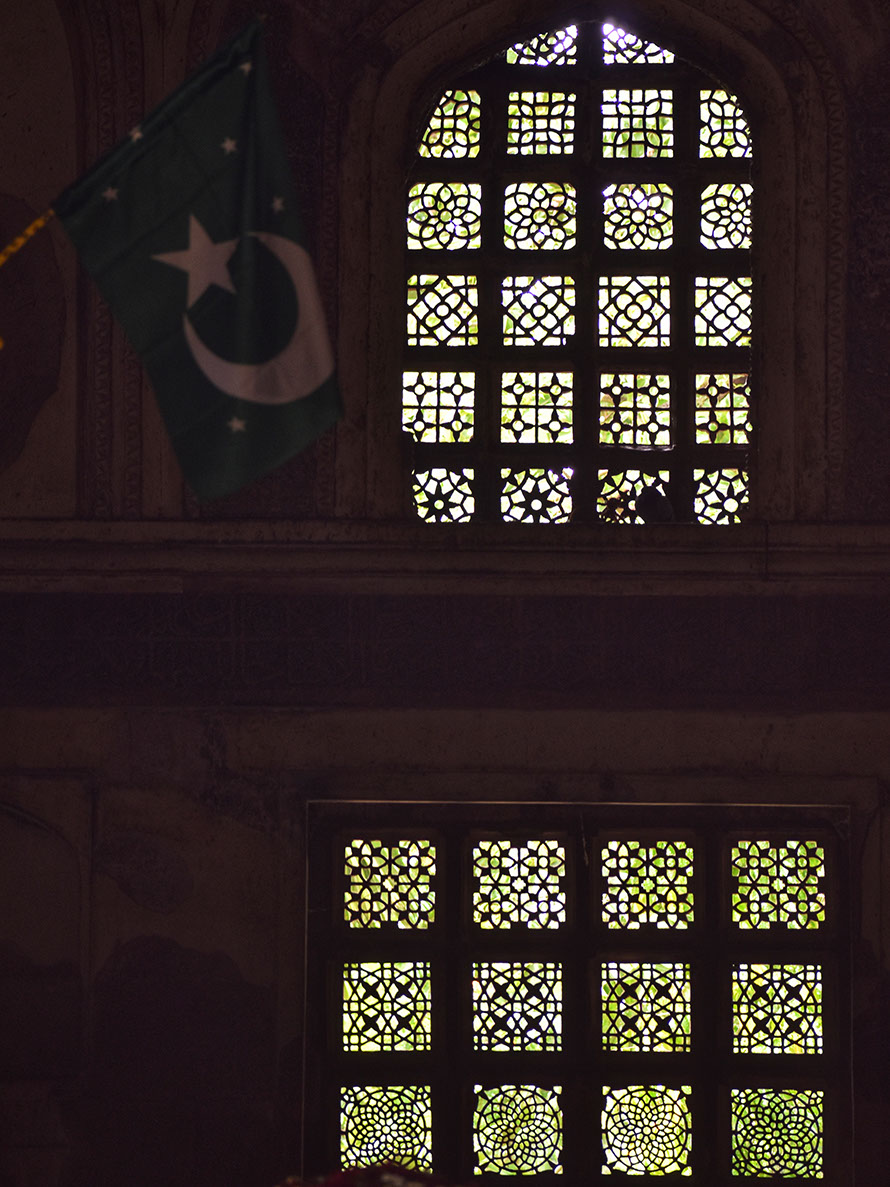
"Jalis" inside the chamber adorned with Quran Verses
The Qutubuddin Maqbara is one of two heritage sites maintained by ASI in Vadodara. This 400-year-old ancient monument is open daily from 8 am to 6.30 pm, except on Thursdays. It is best to visit in the late afternoon when the sun penetrates through the finely carved "jalis" casting geometric patterns on the wall. Although I was unaware of this, I was lucky to experience it during this time.
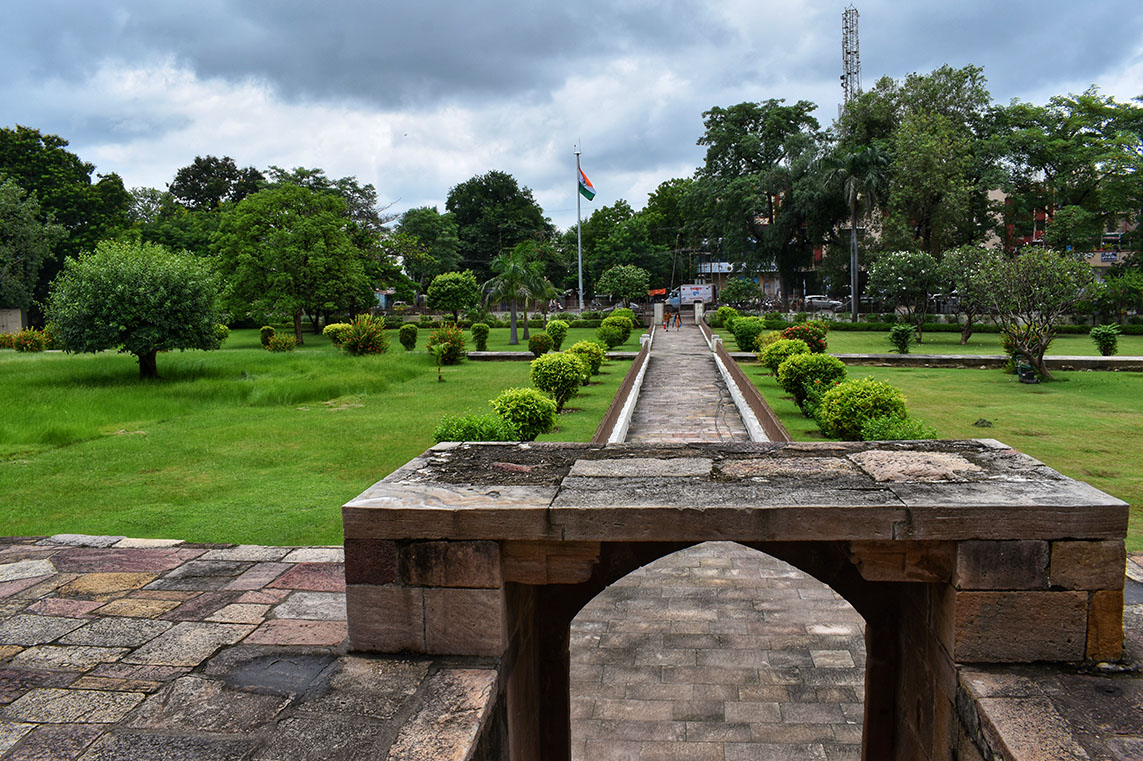
The persian garden surrounding Qutubuddin Maqbara
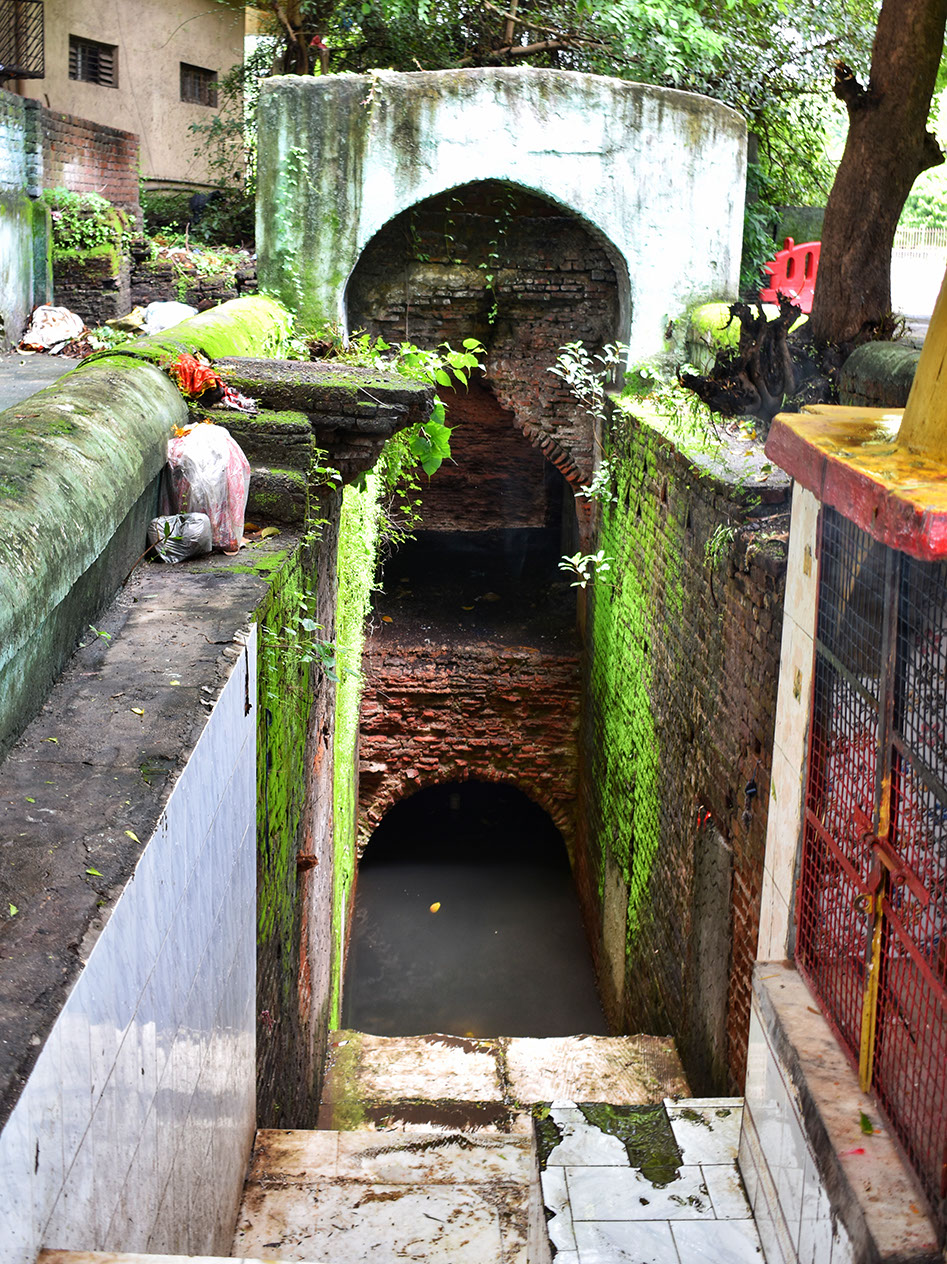
Small step well across the road that used to feed water to the garden
The day had been devoted to heritage sites, and there was no better way to cap it off than with Vidyadhar Vav, an undiscovered stepwell on the outskirts of Vadodara. It was 15 km from Maqbara, and I had to get there before it got dark. I tried Jugnoo, a ridesharing app popular in Gujarat. It didn't take long for me to get a ride. A motorbike ride with Swapnesh Bhatt took me to Sevasi village within 25 minutes. He was well acquainted with shortcuts and roads with less traffic.
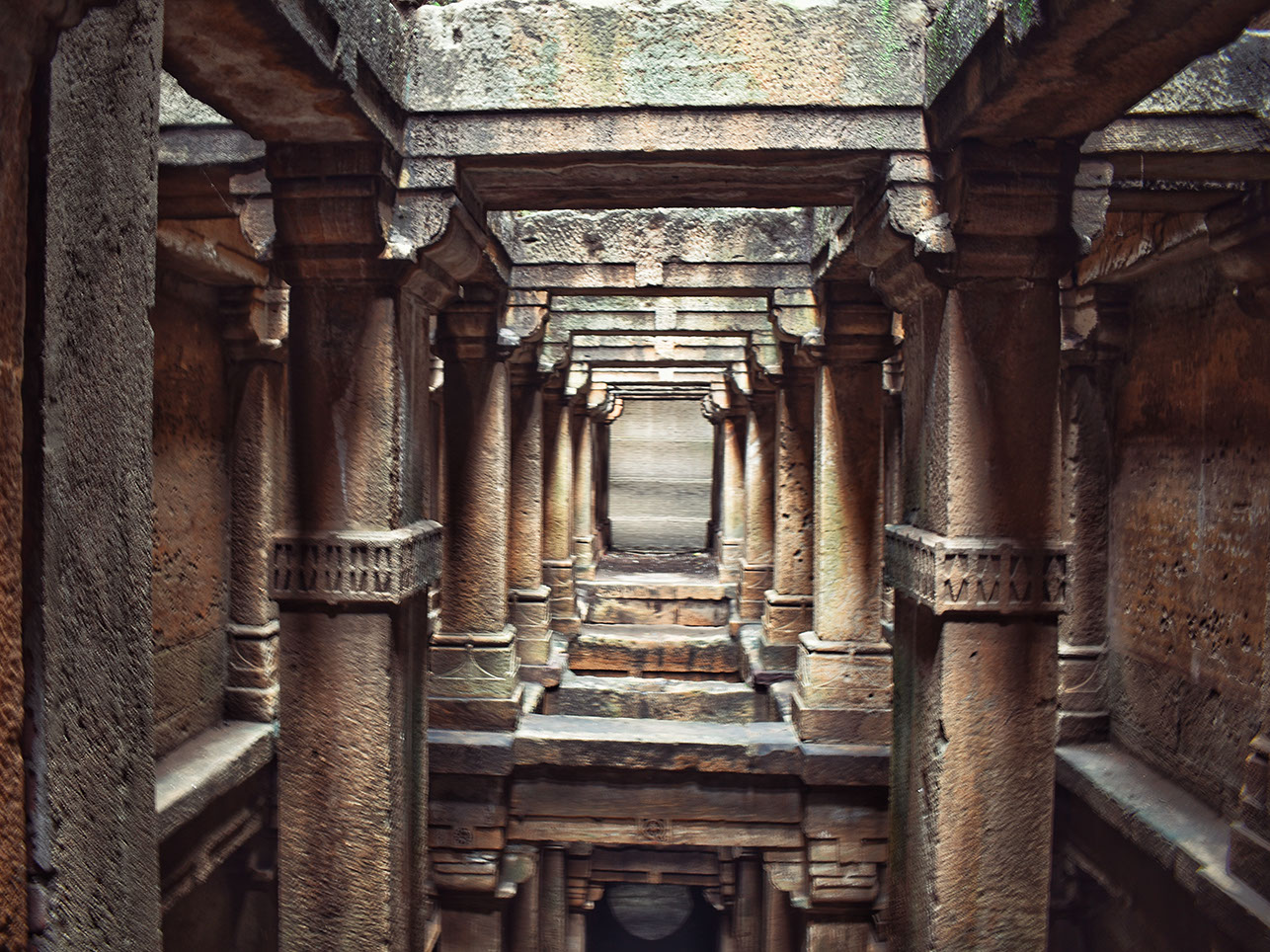
Entering the stepwell was like entering a mysterious dungeon
The stepwell is sploshed with rich sculptures of every inch of its surface, each with a fascinating piece of yesteryear narrative. Historically, Raja Haridas (the King) constructed the stepwell in 1543 to honor Vidyadhar, the spiritual leader of Sevasi village. This piece of history is mentioned in the sanskrit inscriptions on the walls. Unfortunately, the site has been completely neglected and is slowly deteriorating. Several attempts have been made by locals in the village to draw the attention of the authorities to the issue, but nothing significant has been accomplished.
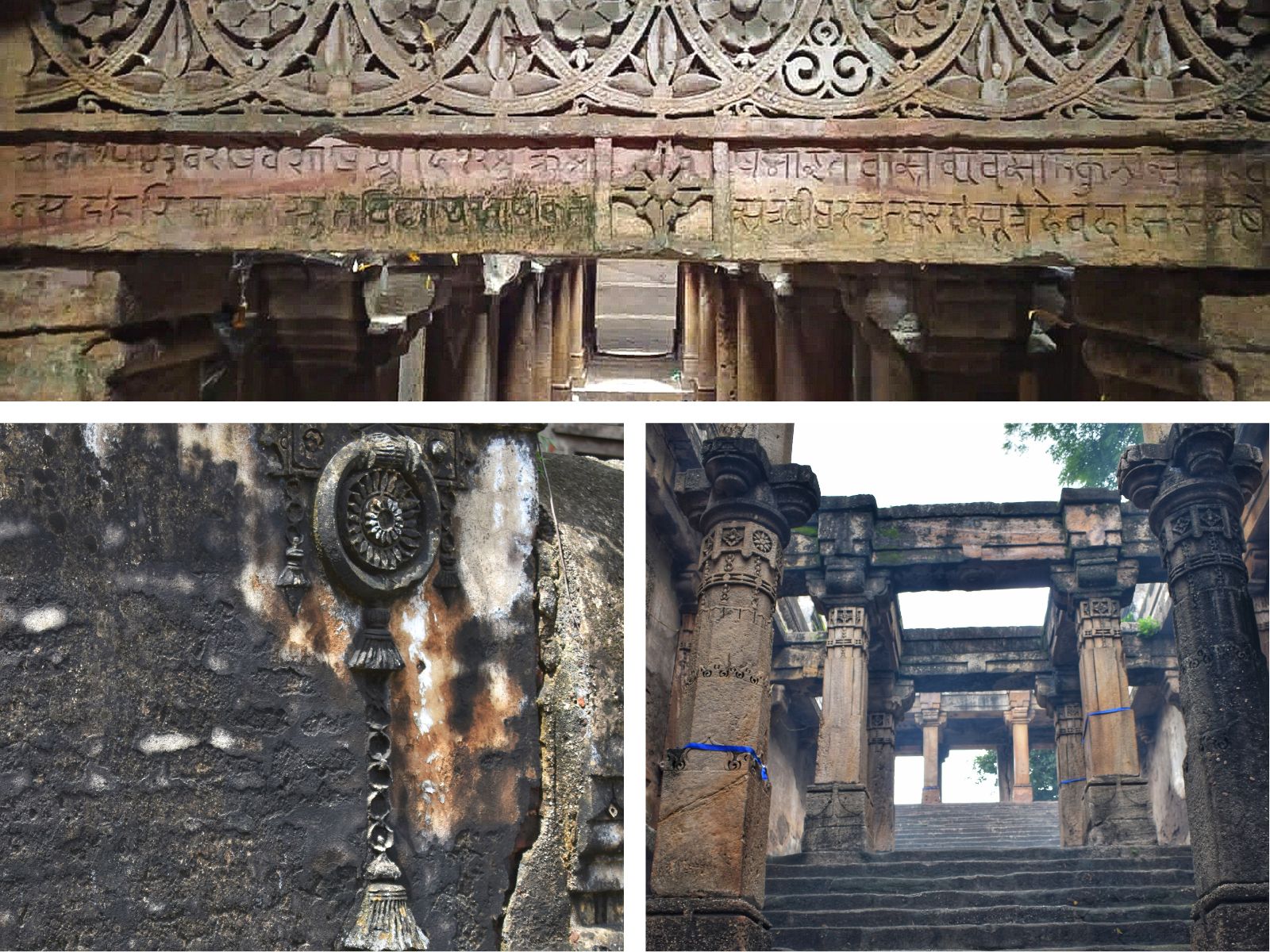
Fascinating pieces of yesteryear narrative adorn the walls of the stepwell
This 7-level underground structure of Sevasi Vav was built with brick walls and stone pillars to provide a strong foundation. Stepwells are usually oriented east-west, and this one is no exception. I was intrigued by the maze-like structure carved on the walls of the stepwell as soon as I descended to the first underground level. It looked like a blueprint map of the Vav. While I tried to gather more information about it, I found only few people are knowledgeable about it.
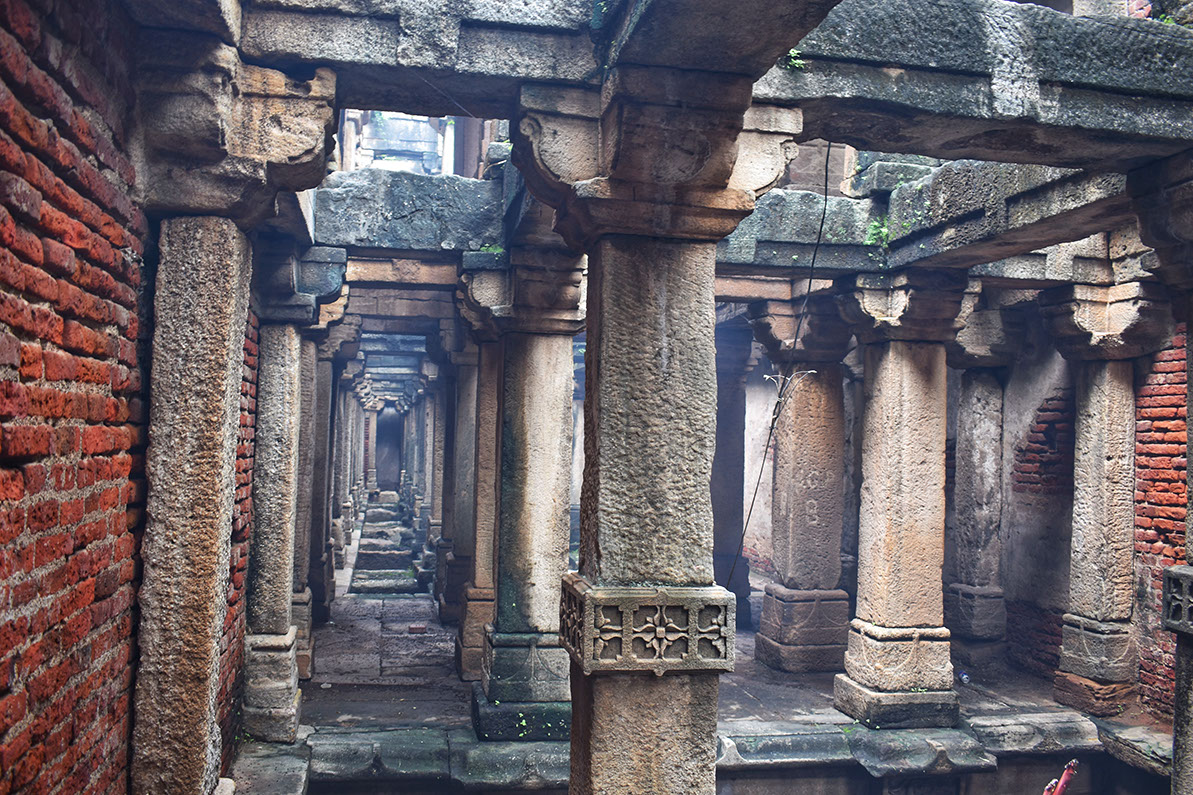
The intriguing stepwell of Sevasi
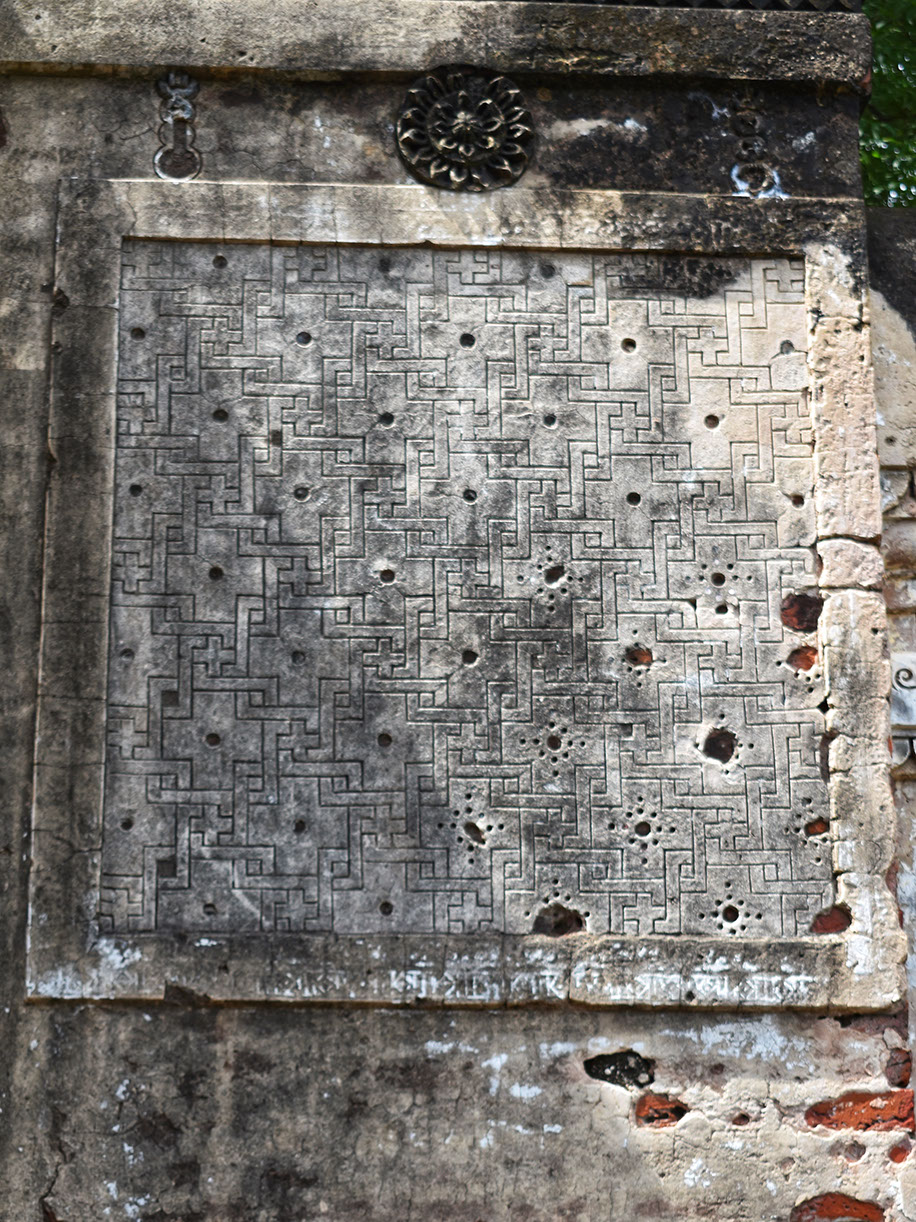
An outline of Vidyadhar Vav's structure
As I looked at the pillars, I was amazed at how they were adorned with torans, flowers and animals. I was impressed with the wall mounted jharokhas, as I continued downward, I could not take my eyes off it. There appears to be a story associated with each of them based on Indian mythology. On the 2nd floor of the Vav, locals perform puja regularly in a small temple. When I visited the vav, it was engulfed in smoke following the performance of a "havan" (the ritual of burning offerings to God on special occasions). In order to take interior pictures, I had to wait for it to settle down a bit.
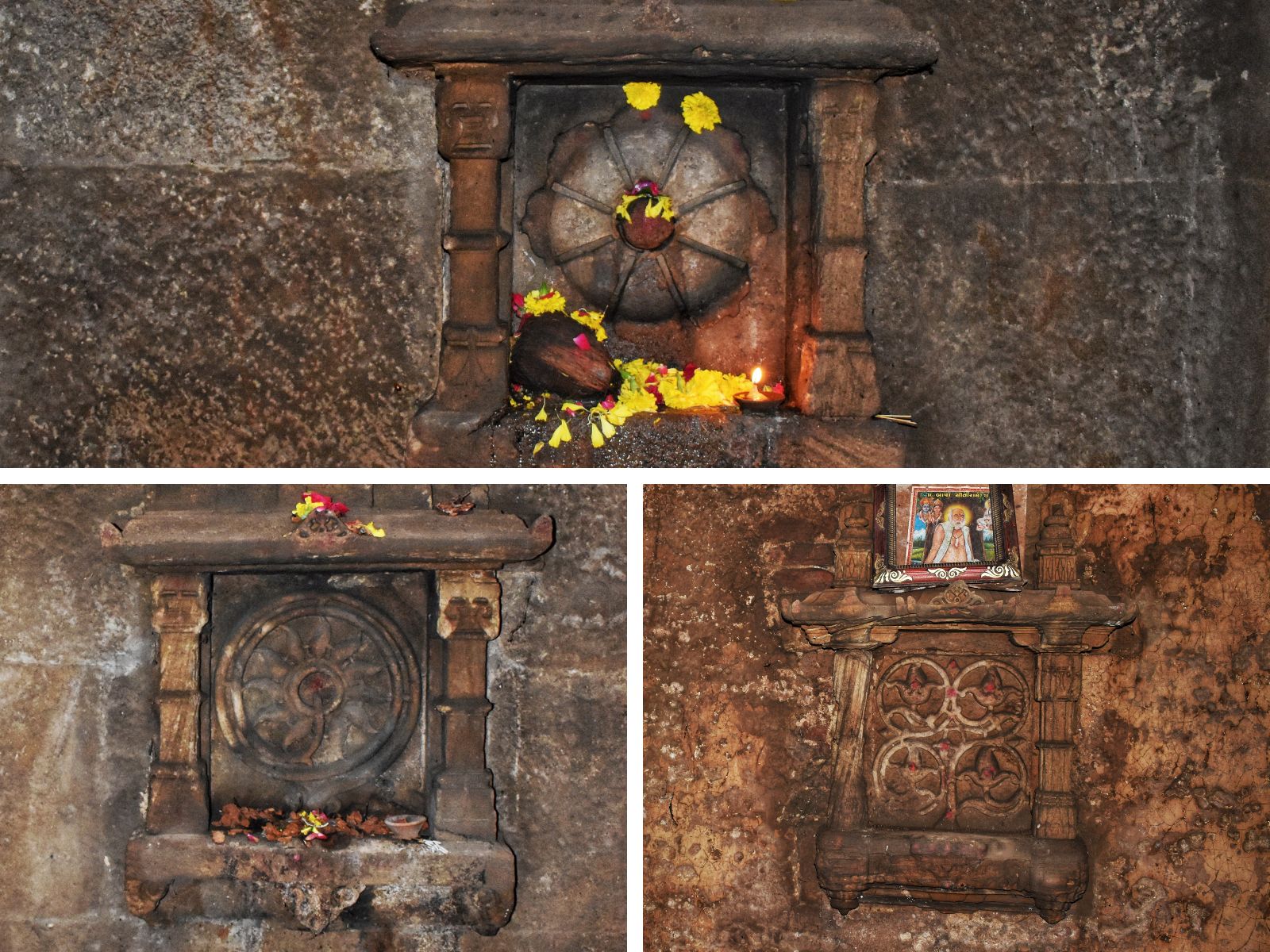
Jharokhas display carvings of Shivalinga with 8 Naags (top), Krishna's Sudarashan Chakra (bottom-left) and Ganapati (bottom-right)
As I strolled along the length of the Vav from the sideways, I eventually reached the center of the stepwell. A glance down the dome provides a sense of the depth of the seven stories. In order to descend from the upper level to the lowest level, there are two adjacent spiral stairs. Usually, I take these stairs down because it offers quite a different experience and it takes you quite close to the water-filled dome. However, looking at the damaged walls and plaster of the stairs, I preferred to avoid it. There's a horrifying myth that tells a story about young girls decked with jewelery being sacrificed here in the water to ensure the prosperity of the Vav.
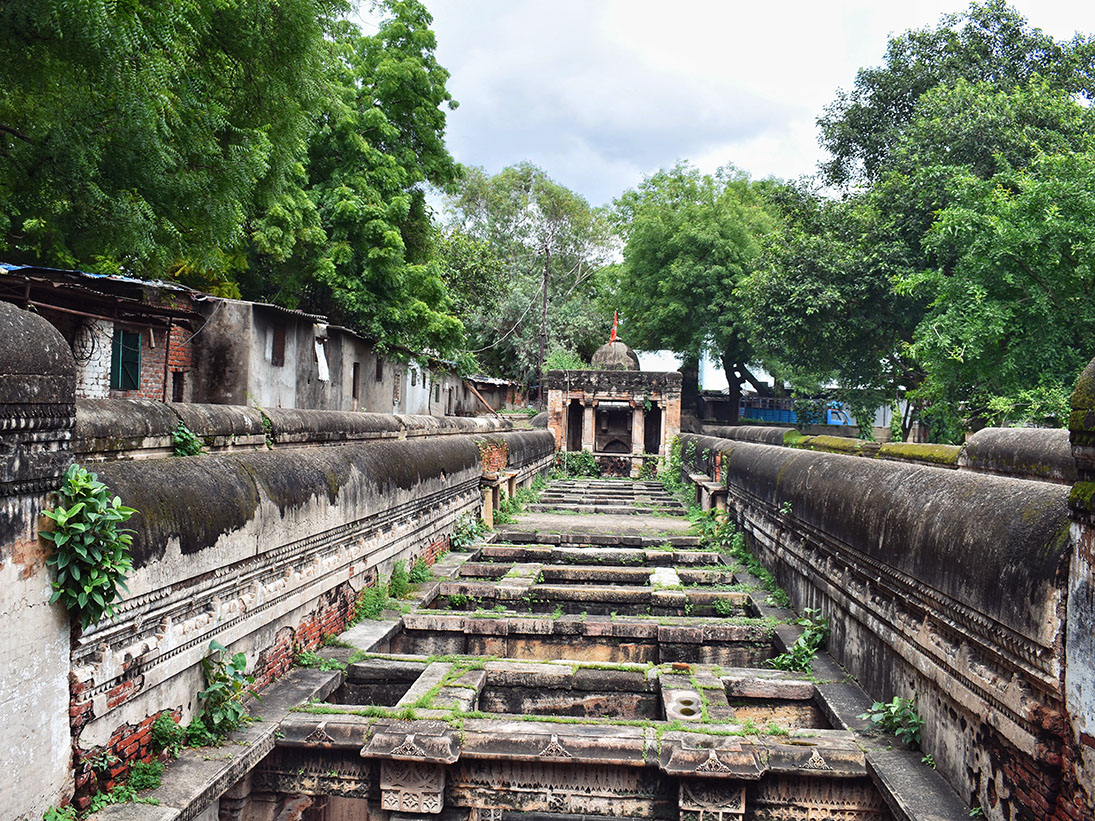
The top view of Sevasi Vav
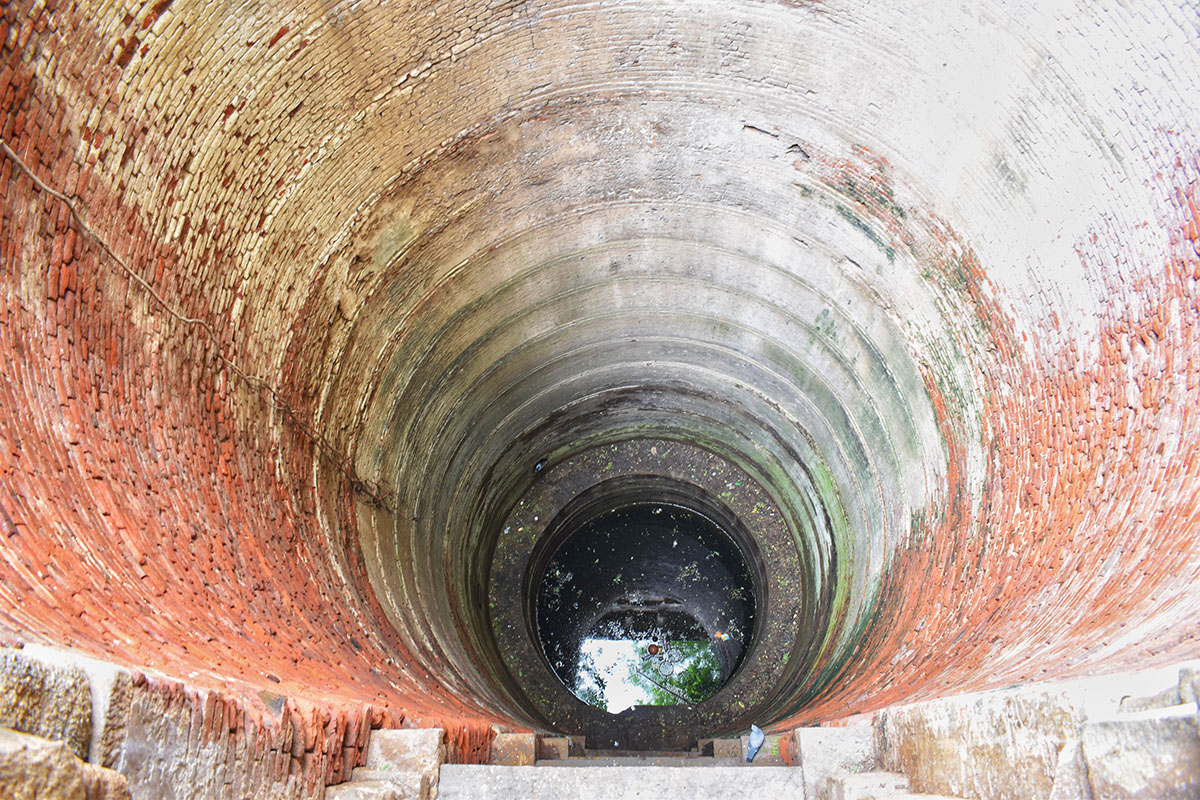
View of the dome from the upper floor
I proceeded onto Sevasi, which is a remote location, so I requested Swapnesh to wait for me there as my next destination was the old British Cemetery. He gladly obliged and even offered to drive me back to my hotel after my visit was completed. This cemetery, which dates back more than 100 years, contains the graves of British soldiers who served in Baroda state. The cemetery contains some of the most magnificent tombstones and sculptures. During my visit, the entire cemetery was covered with thick, tall grass. I believe the cemetery is still in use as it contains graves of the deceased in recent years. The address on Google Maps for this location is incorrect, but the location is perfectly pinned. The place is not even known to many Vadodara residents. Thanks to Swapnesh for finding this place even though I gave him the wrong address. According to him, this place is located in Alkanagar and not in Gorwa.
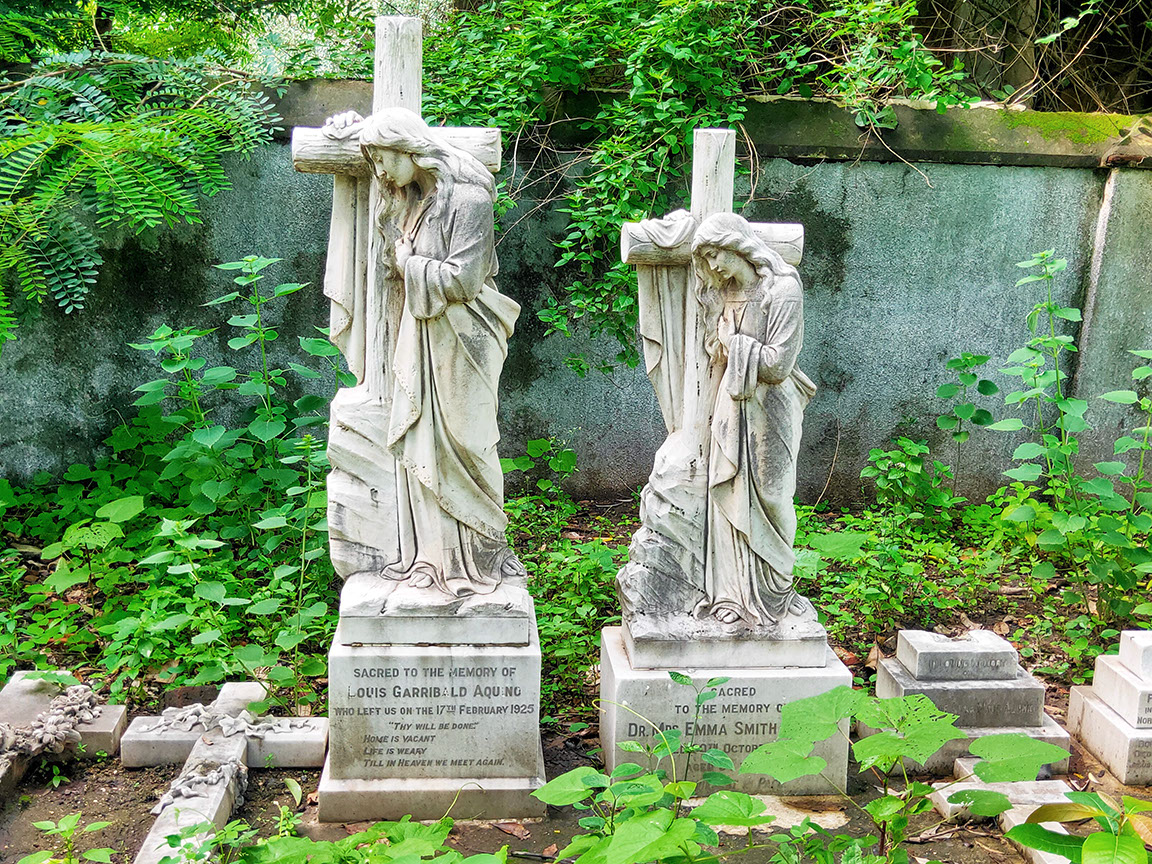
Incredible marble sculptures at British Cemetery
Not only is Swapnesh Bhatt a great rider, but he is also well acquainted with Vadodara. You can reach him on his mobile number +91 92654 08209 if you need his services.
Tourists to Vadodara usually have MS University at the top of their list. I intentionally kept it for the last because I wanted to go there on a public holiday, to soak in all the history and to capture important details at leisure, without the hassle of dealing with a crowd.
Maharaja Sayajirao University (MSU) is a prestigious university that was built in 1881 with the vision of Maharaja Sayajirao Gaekwad III, the then ruler of Baroda State. The massive 275 acre campus houses 90 different streams with the Faculty of Arts being the premier among them. MSU was the only university in Gujarat for over 100 years whose medium of instruction is English for all the courses. Over 100,000 students study here in subjects ranging from arts to engineering to medicine. It is quite renowned for the number of eminent scholars, scientists, administrators and musicians it has produced over the years.
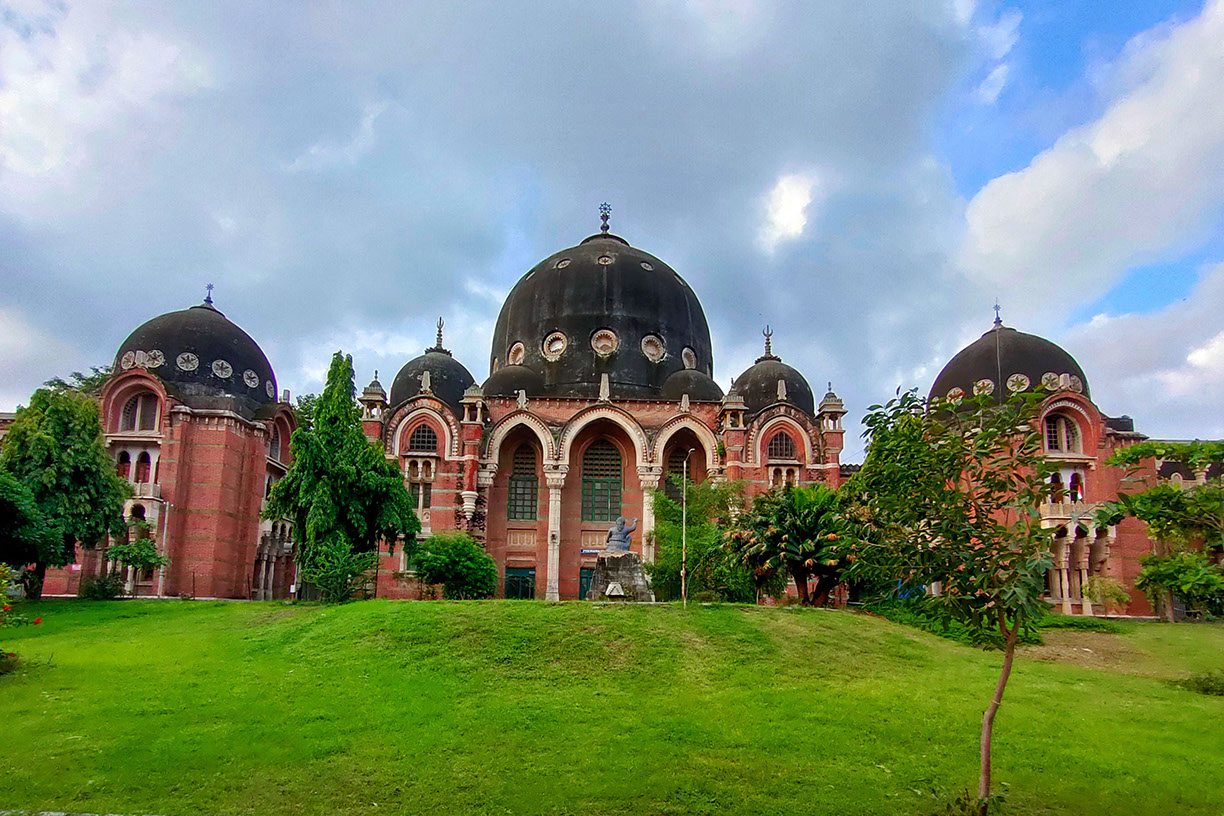
The massive dome in the middle of MS University's Faculty of Arts building
MSU is home to a number of beautiful old buildings, many of which share a similar courtyard architecture with exposed brick facades. However, one building that stands out from the rest is the Faculty of Arts building, which is a unique amalgamation of architecture from different cultures ranging from Buddhist to Ottoman. The "E" shaped building has a massive 70-foot diameter dome surrounded by 8 other domes on both sides. There are rows of star-shaped windows in each dome that let sunlight into the building, draping it stunning brightness.
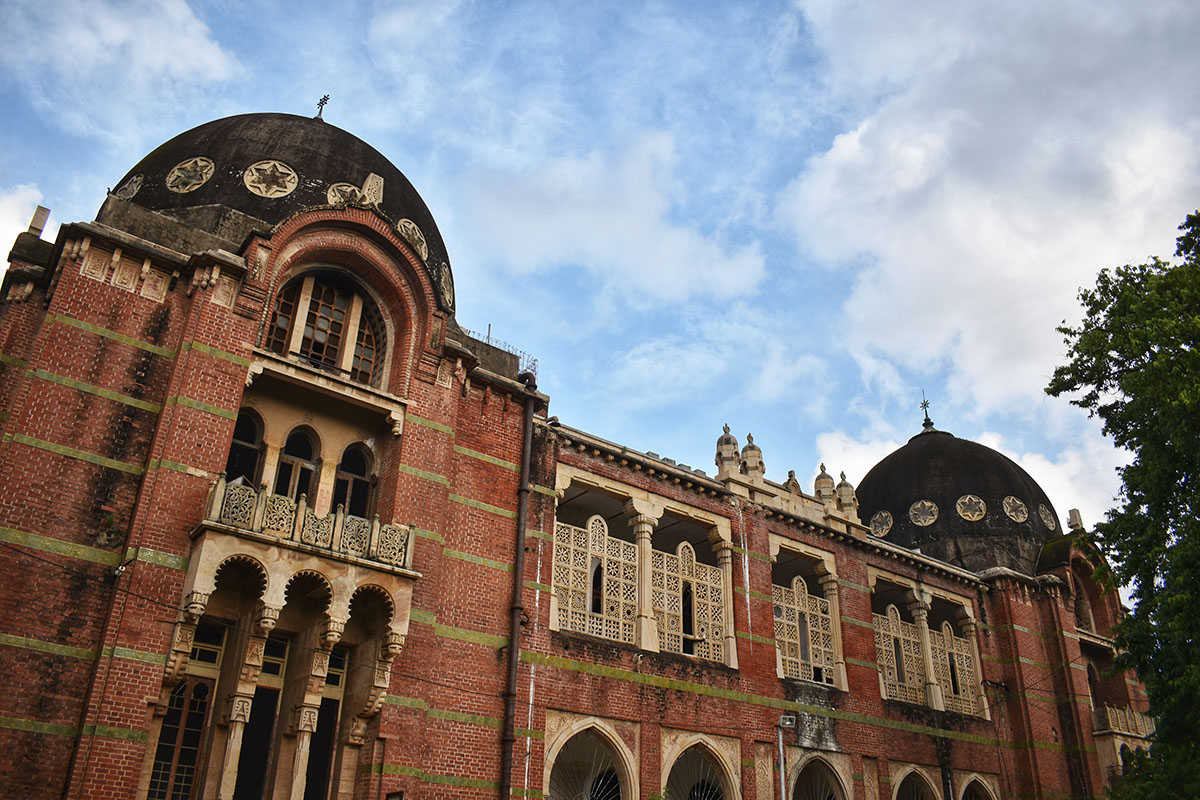
University building with star-shaped windows, jharokhas, and jhalis
This was a really special tour for me. I loved every bit of the journey and each discovery fueled my imagination that galvanized my quest to learn more about each place. Some of the pieces of history or art that I stumbled upon have left their indelible mark and I think I will carry those memories with me to all the new places that I travel. I especially loved the discovery on the walls at the unassuming Tambekar wada, for me that was a historical find. The stories from those intricate vibrant walls still echo through my mind on still nights.
I will always recall the erratic beat of my heart as I descended down the stepwell, in edgy anticipation and a fear of the unknown, just wondering what delights awaited me. Every structure beguiled me and I was awed by the skill and expertise that the sculptures of those times displayed. Each spot had its own unique impact on me and I feel blessed to be able to narrate these stories. I hope, when you visit this charming, magnetic city, you will be able to see it through my lens. I also hope you can capture moments into memories and stumble upon more new discoveries like I did, so we can together add to the treasures of the great historical legacy that this city will forever hold.
Vadodara, Gujarat, is a culturally rich and vibrant city that is known for its palaces, temples and museums, as well as its delicious food. The city is also home to the Maharaja Sayajirao University of Baroda. Founded in 1881, the university is one of the oldest in India and is considered to be one of the country's leading centers of learning.
While Vadodara is best known for its palaces and temples, the city also has a number of lesser-known attractions that are well worth a visit. For example, Tambekar Wada is a 170-year-old building with exquisite mural paintings. Vidyadhar ni Vav or Sevasi Vav is another hidden gem, offering a peaceful oasis away from the hustle and bustle of city life. And for those interested in history, the Baroda Museum & Picture Gallery boasts an impressive collection of artifacts from across the globe.
No, there is no entry fee to Sayaji Baug garden. It remains open from 5 am to 8 pm every day. Joy train ride, zoo, museum, and planetarium are all paid attractions.
Sayaji Baug covers an area of almost 100 acres and is home to a variety of plants, trees, and flowers. Visitors can also see a number of sculptures, fountains, and an amphitheater. It also has a zoo, a museum, a planetarium, and a joy train ride.
An old Maratha mansion, Tambekar Wada is 170-years-old. Its architecture and mural paintings from the 17th and 18th centuries are stunning. The paintings represent the different schools of art in Vadodara during that time period. It is now a museum and a national heritage site.
Qutb-ud-din, the then governor of Gujarat between 1573 to 1583 built the Hajiro, also known as the Maqbara. The mausoleum contains tombs of Qutb-Ud-Din and his family members.
Disclaimer: This blog may contain affiliate links. At no extra cost to you, we may get a small commission if you buy anything. All products and services we endorse have been personally used or come highly recommended to us. These incomes allow us to keep the community supported and ad-free.
Name
Email
Comment